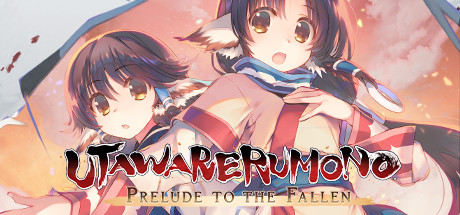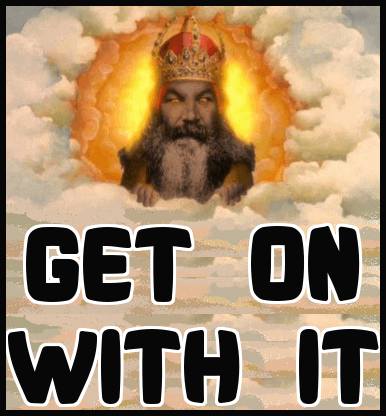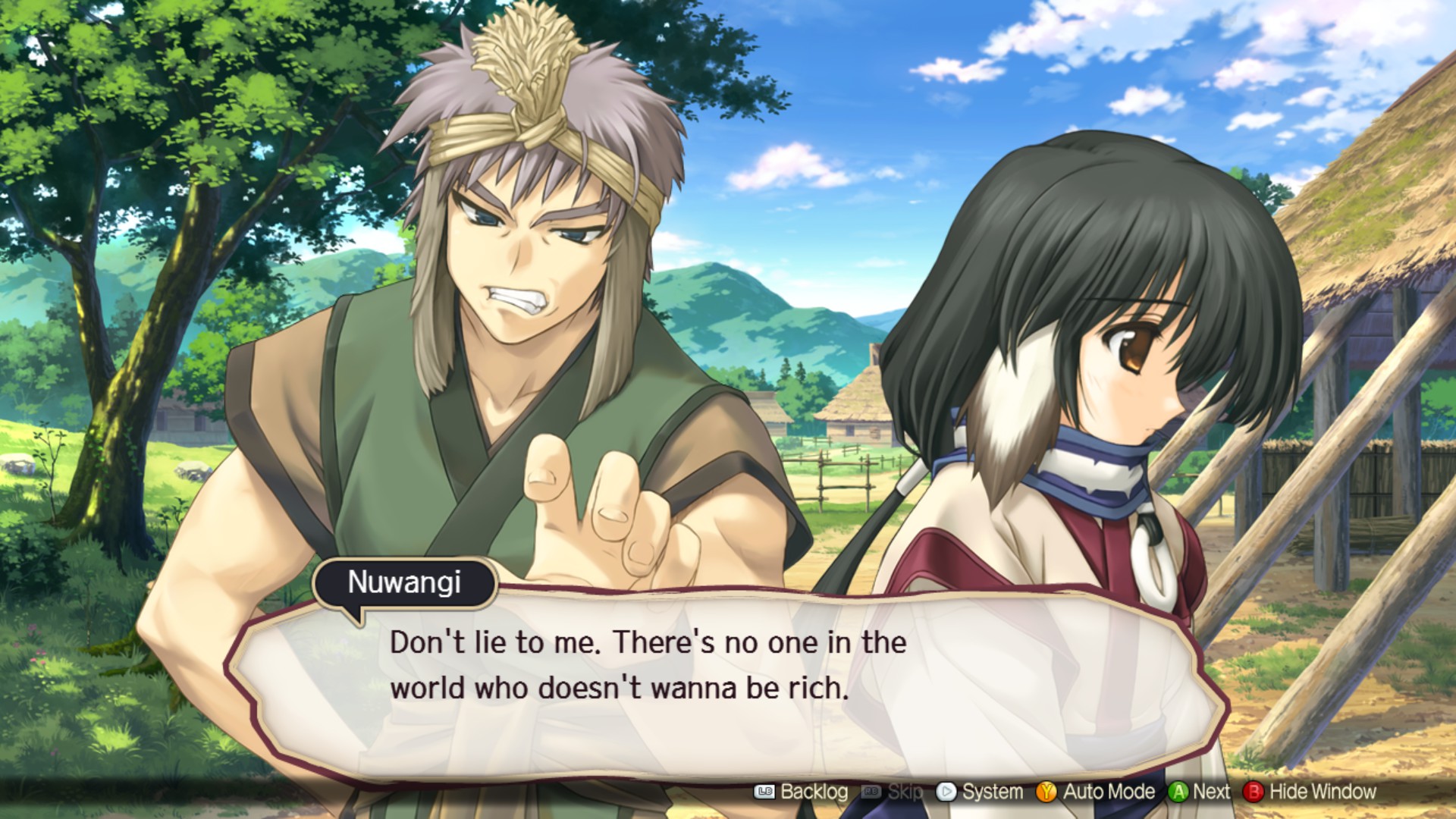It’s an Utawallright port.
Type: Single-player
Genre: JRPG, Tactics RPG,
Visual Novel
Developer: AQUAPLUS
Publisher: DMM GAMES,
Shiravune
Release date: 22 Jan, 2021


Intro
Utwarerumono: Prelude to the Fallen is the re-re-re-release of what was a game first released in 2002, being released on six different platforms, including PC in several different versions (including this one), making this game behind only the likes of Skyrim, DOOM, or anything Nintendo owns the rights to from the NES days for the number of re-releases and ports it gets to different hardware. This isn’t even counting the manga, the full-length 2006 anime (which was quite well-received and can be viewed on Funimation), another manga, a movie, and two even longer sequel games that got their own multiple releases and spin-off media like anime. With that said, this release marks the first official release of Utawarerumono in English on the PC, even though an unofficial translation patch for the original game has been around for over a decade.
For those curious about the title that just rolls right off the tongue, “Utawarerumono” is made up of three words mashed together, and literally translates to “[the] thing [the] singing is [about]”, although a more illuminating translation would be “The One of Whom Legends Are Sung”.
DangerHighDoltage made a review for the PS4 port last year written as someone who had played other Utawarerumono games and seen the anime and generally already been a fan, however, being as this game may well be older than some people reading this review, and this being my first real experience with Utawarerumono, personally, I’ll be writing a review that covers the whole game for someone new to the series. Those who know the game and simply want to know if this is a good port need only read the first section after this and then skip to the Verdict at the bottom.
So Is It a Good Port?
Well, I had no problems with it.
I should note that there were people in the Steam reviews and forums saying that they suffered from screen tearing in the 3d battle segments on AMD cards. I use a GeForce, so I cannot speak to this except to say that it wasn’t an issue I suffered from. If this would be a deal-breaker for you, consider hitting the skip button up to the first battle, and seeing if this problem affects your rig and consider refunding from there.
Another issue people might have is that the art assets are from an earlier port and are therefore all made for a 720p resolution, with the game upscaling to other resolutions, which can result in some blurriness, but obviously not as much as from a 640×480 resolution. Here is a good example image with some details in both 720 and 1080 resolutions for comparison:
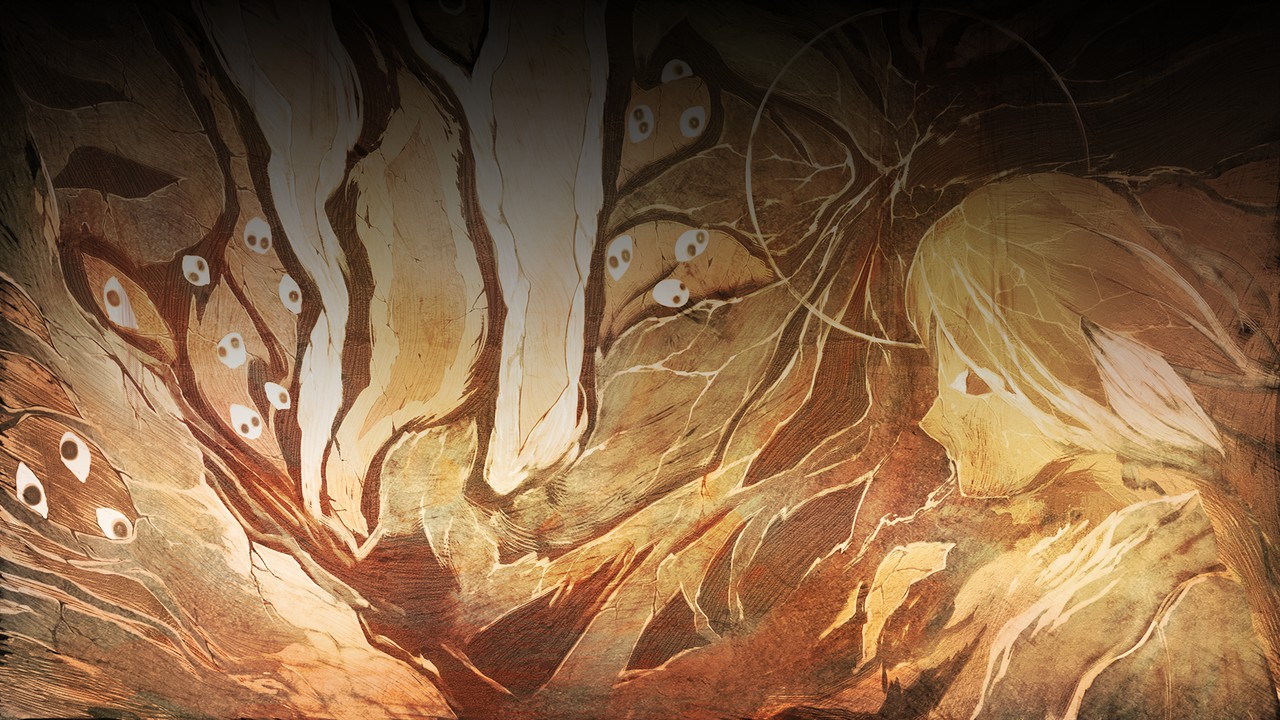
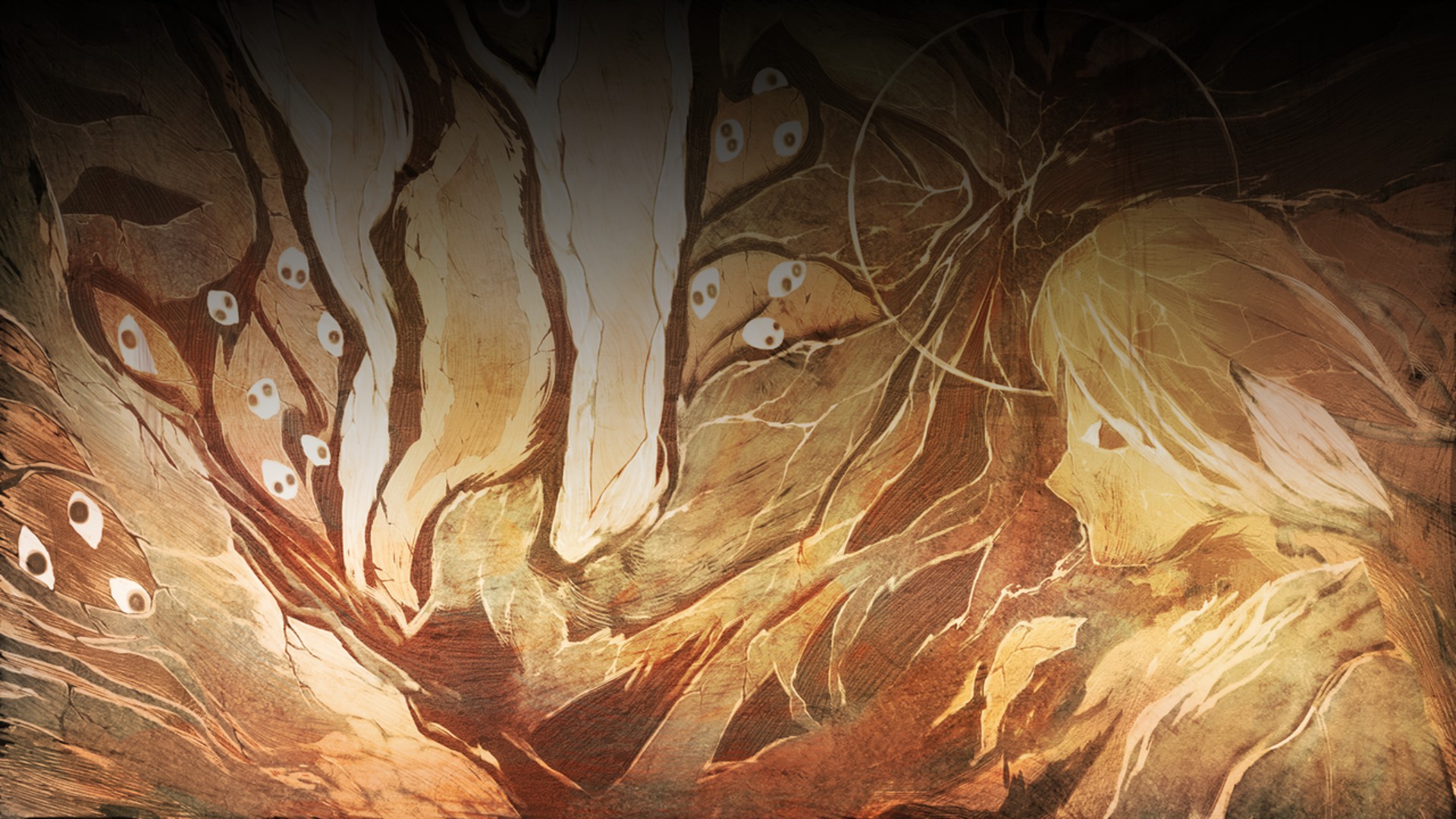
I personally don’t find this enough to worry about, but others may disagree.
Combat takes place in 3d, and the legacy of being a PlayStation 2 game is clear in the polygon count. Being a re-re-re-re-release, I doubt that Shiravune was given the funding or has the sales expectations to justify remaking all the graphics, so they are clearly reusing graphics from earlier ports, and focusing simply on making the game run well on PC and have options.
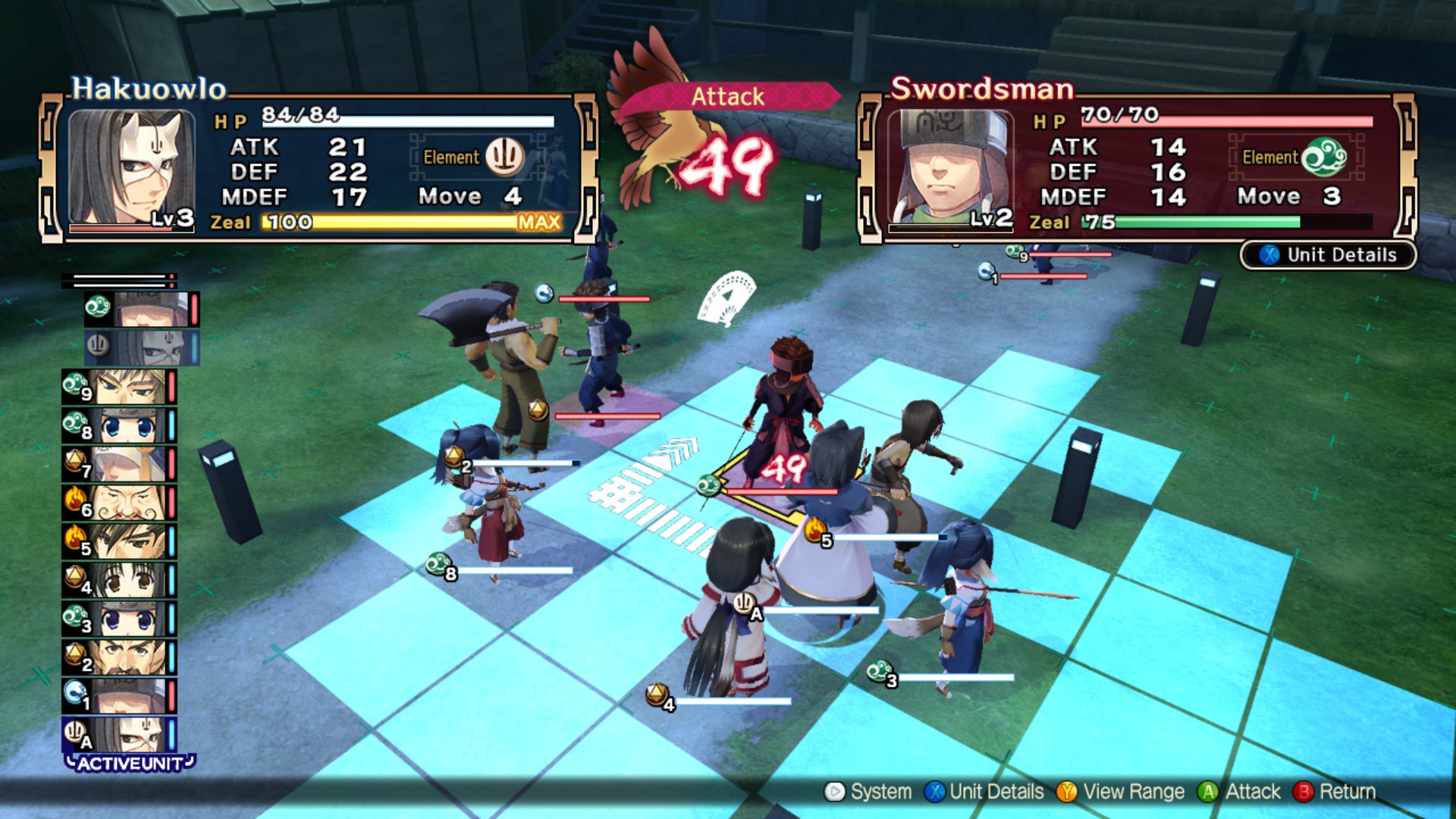
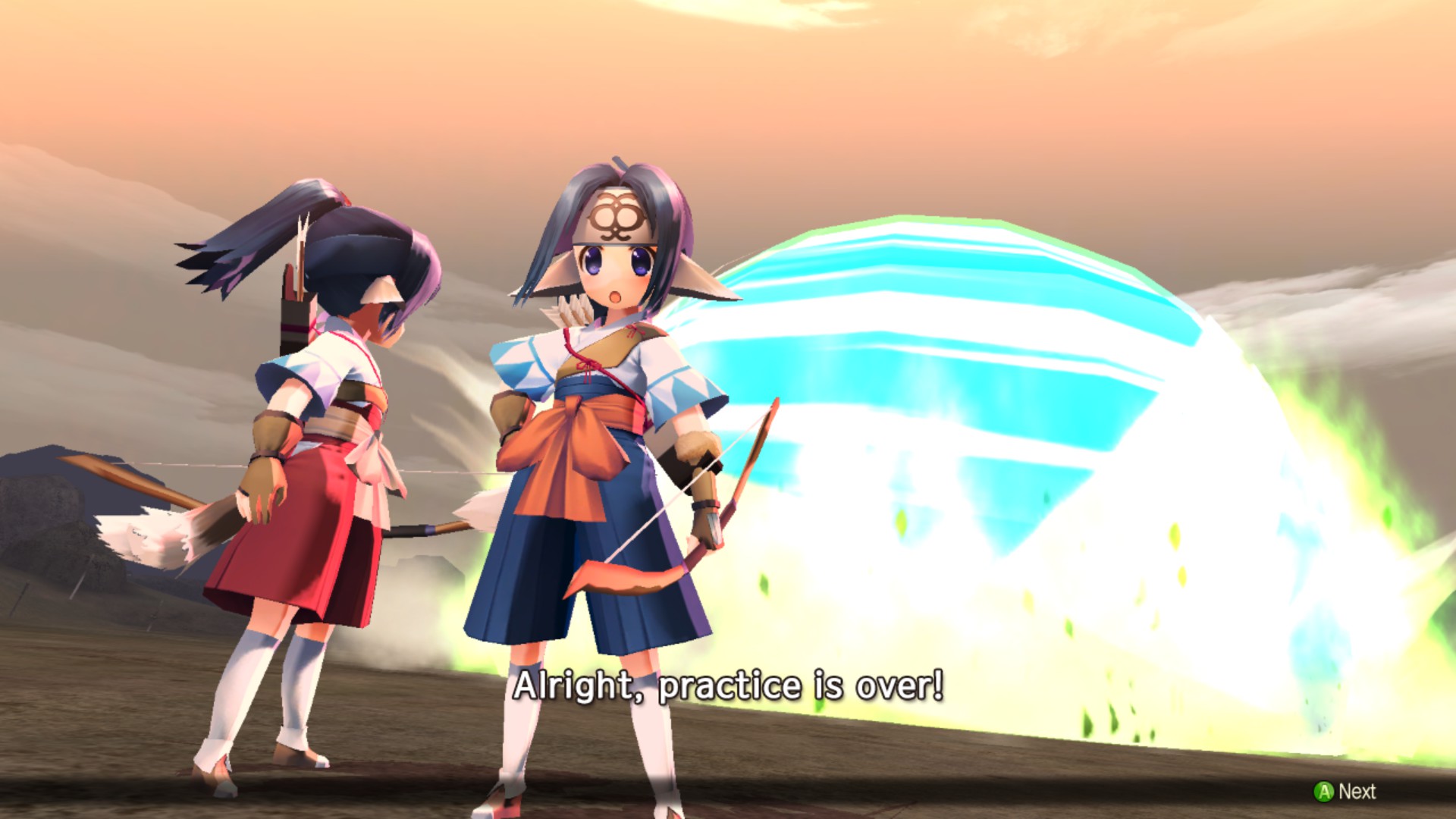
With that said, the PS2 is the era where 3d graphics started to get decent enough that they could age well, and HD re-releases that just allow for HD aspect ratios are still acceptable. I haven’t played the series before, and I don’t feel let down, but I could see someone who already purchased the game on PS4 finding the lack of upgrades from last year’s release to be a good reason to skip this one, at least until you’re ready to bury your PS4.
As far as control options go, this port has full key rebinding options for keyboards, although you’ll find that the game can almost entirely be played with the mouse, especially the visual novel sections. Controllers have a pre-defined control scheme, however, unless you use 3rd party software or the Steam controller software to alter them.
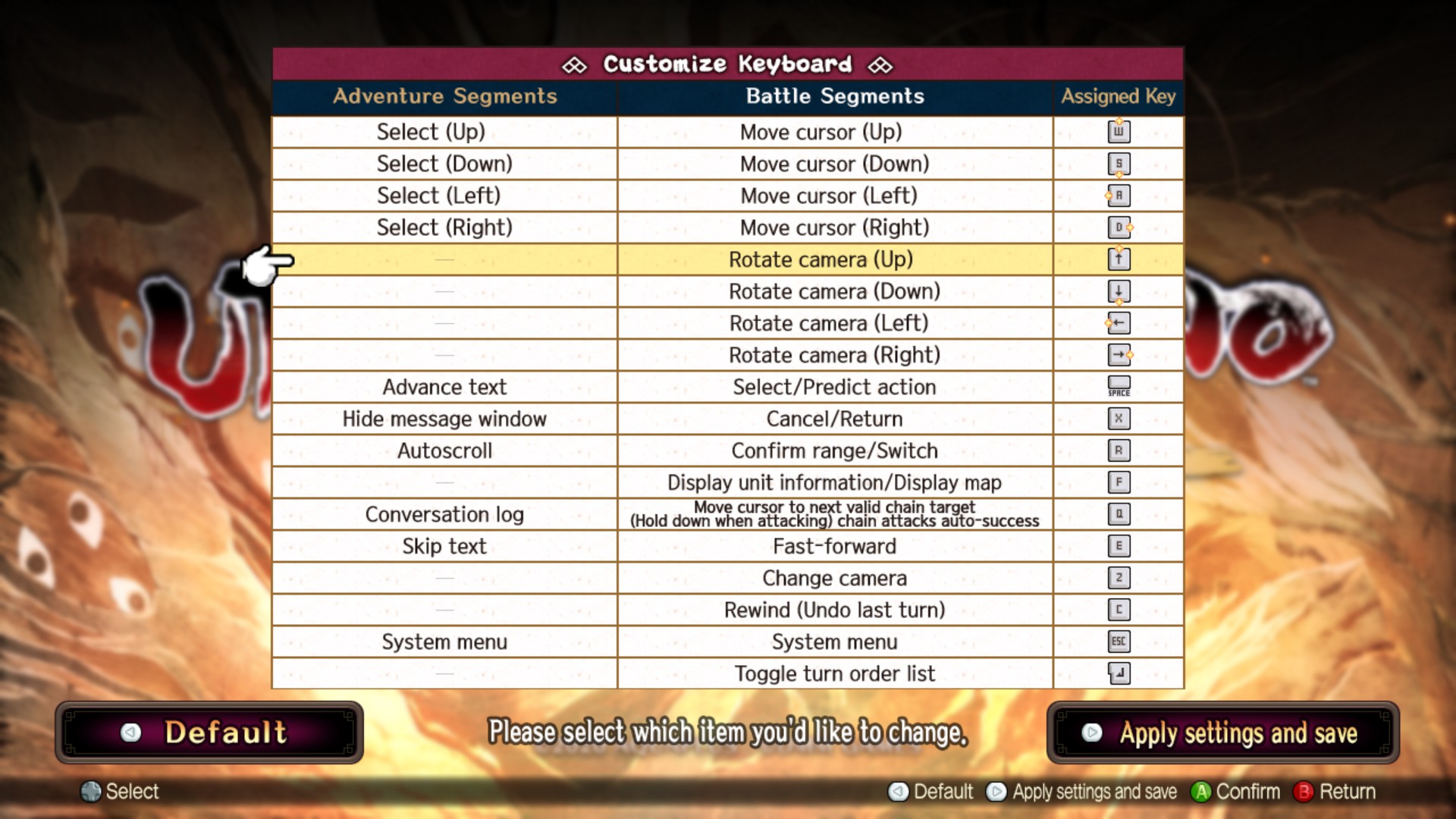
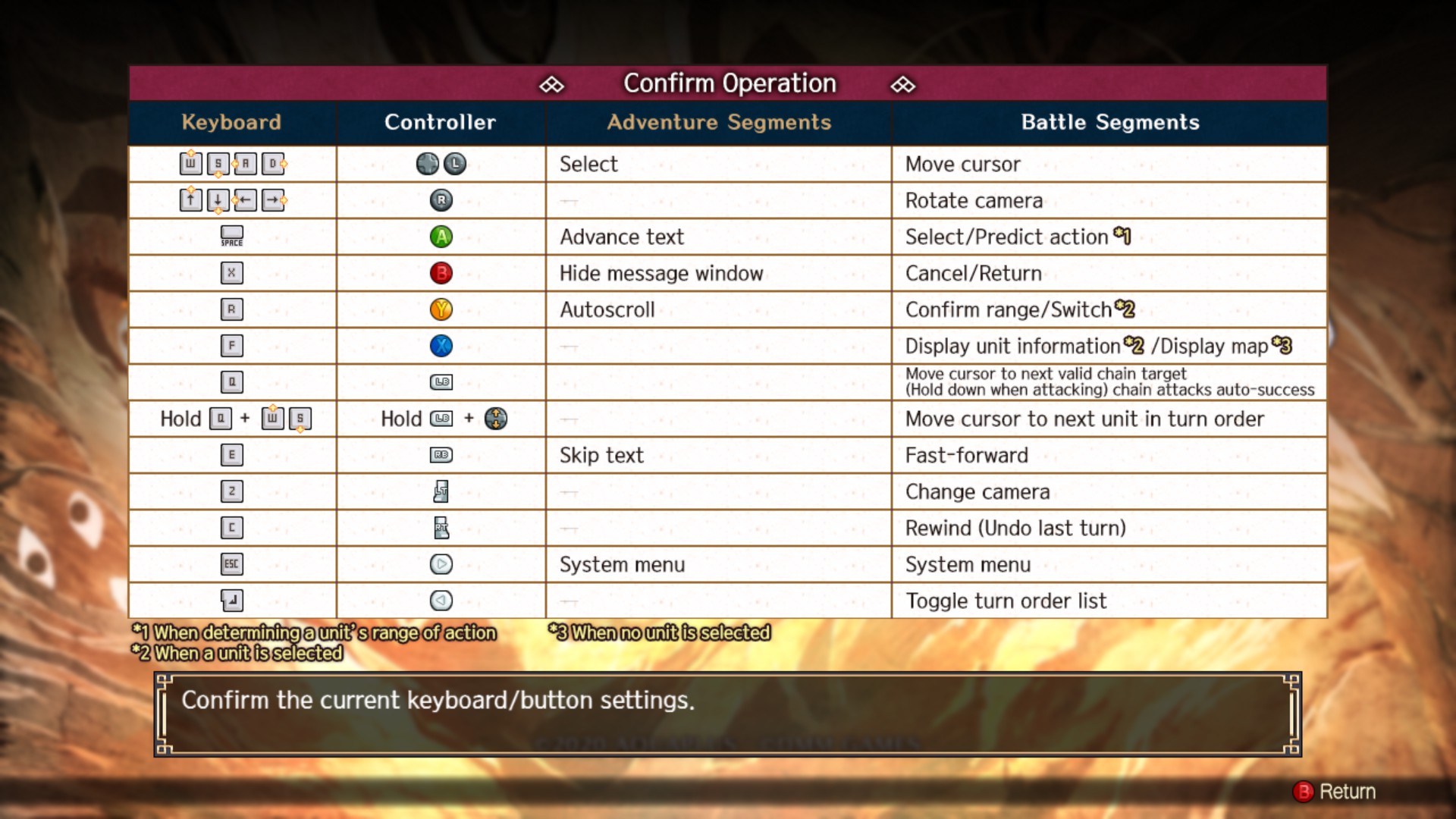
In fact, there is even an option in the menu to choose which button prompts appear on-screen, choosing between your customized keyboard controls, XBox controller, Switch controller, or PlayStation controller buttons, so that button prompts match your trained controller memory, although this isn’t as important since this games lack a QTE with button prompts besides the same “confirm” button every time.
So far as performance goes, I came across no noticeable framerate stuttering or other problems. I only find load times as the 3d battle maps are brought up, and the loading time is less than a second, with the only amusing loading artifact being that character models can take an additional second to load in. My rig is only a year old and so it may be faster than others, but this is a game that uses only about 600 MB of memory, less than a single core of my CPU, and is almost certainly basically the same version of the game that was ported to the Vita and Android, so few computers weak enough to chug on this game are likely to still be in use at this point.
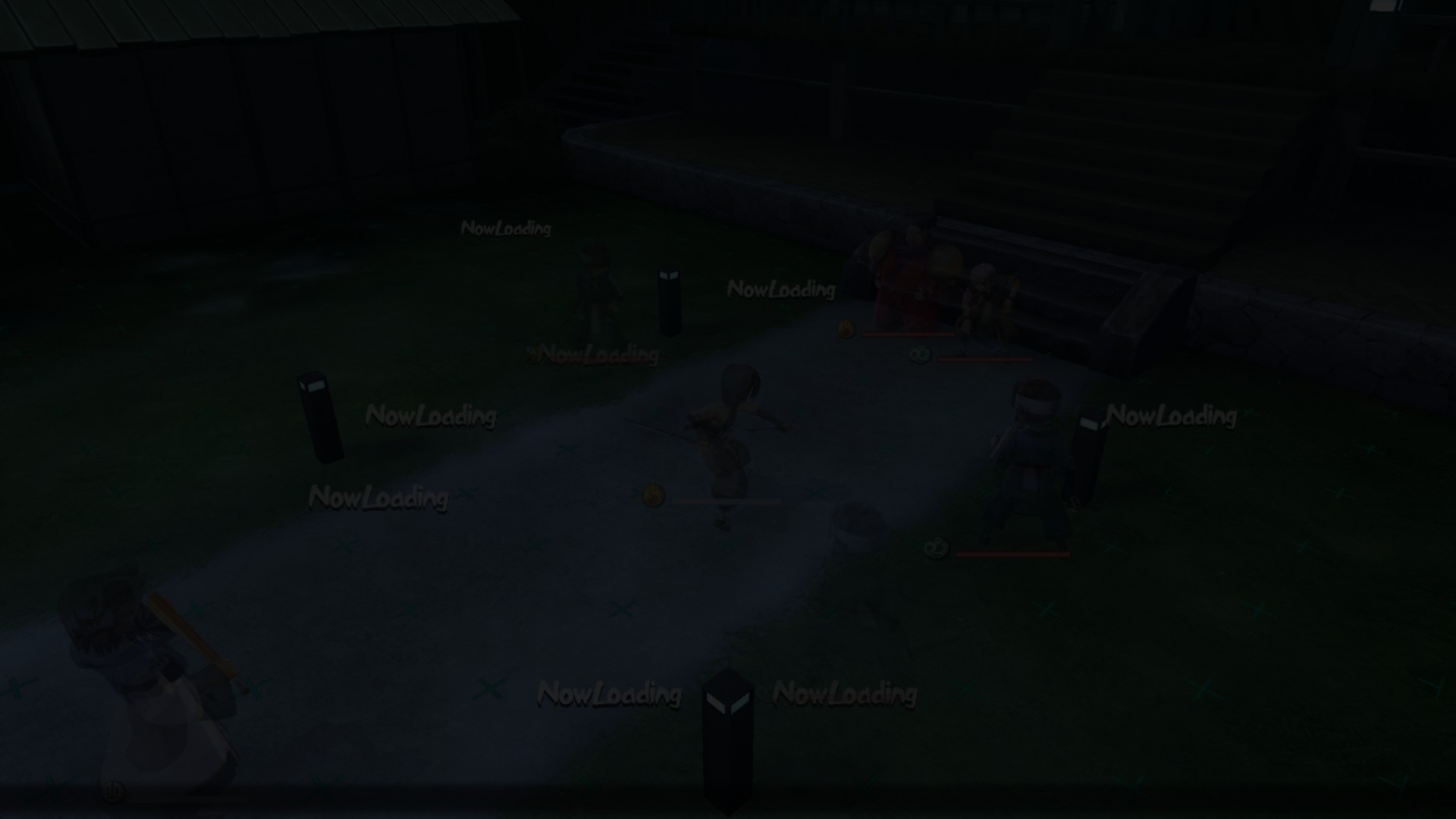
One final disappointment for some, however, is the game being locked at 30 FPS, like all its previous releases. This isn’t an action game, so it will not be as noticeable as in some games, however.
Visual Novel/TRPG Blend
In his review of the PS4 port, DangerHighDoltage described Utawarerumono by saying “this game seriously takes its time to develop each character and their relationships with each other,” and I completely see what he is talking about. The last Visual Novel/RPG hybrid game I reviewed, Undead Darlings, had a split where it started off with about 15 minutes of visual novel before having a small dungeon about 2 hours in length followed by increasingly longer stretches of an hour of visual novel followed by an 8-hour dungeon and so on to the point that I wished the game would break its story and gameplay elements into smaller chunks to keep things interesting. Well, Utawarerumono starts off with something like an hour and a half of visual novel followed by a single 5-minute fight before you get another hour of visual novel followed by a 10-minute fight. The game starts to get more of the combat gameplay the further you go, but it certainly does drag on early in the game with just non-interactive story elements to the point that I’m not even sure how long that stretch was, exactly, as I had to break the game up myself by alt-tabbing out and doing something else.
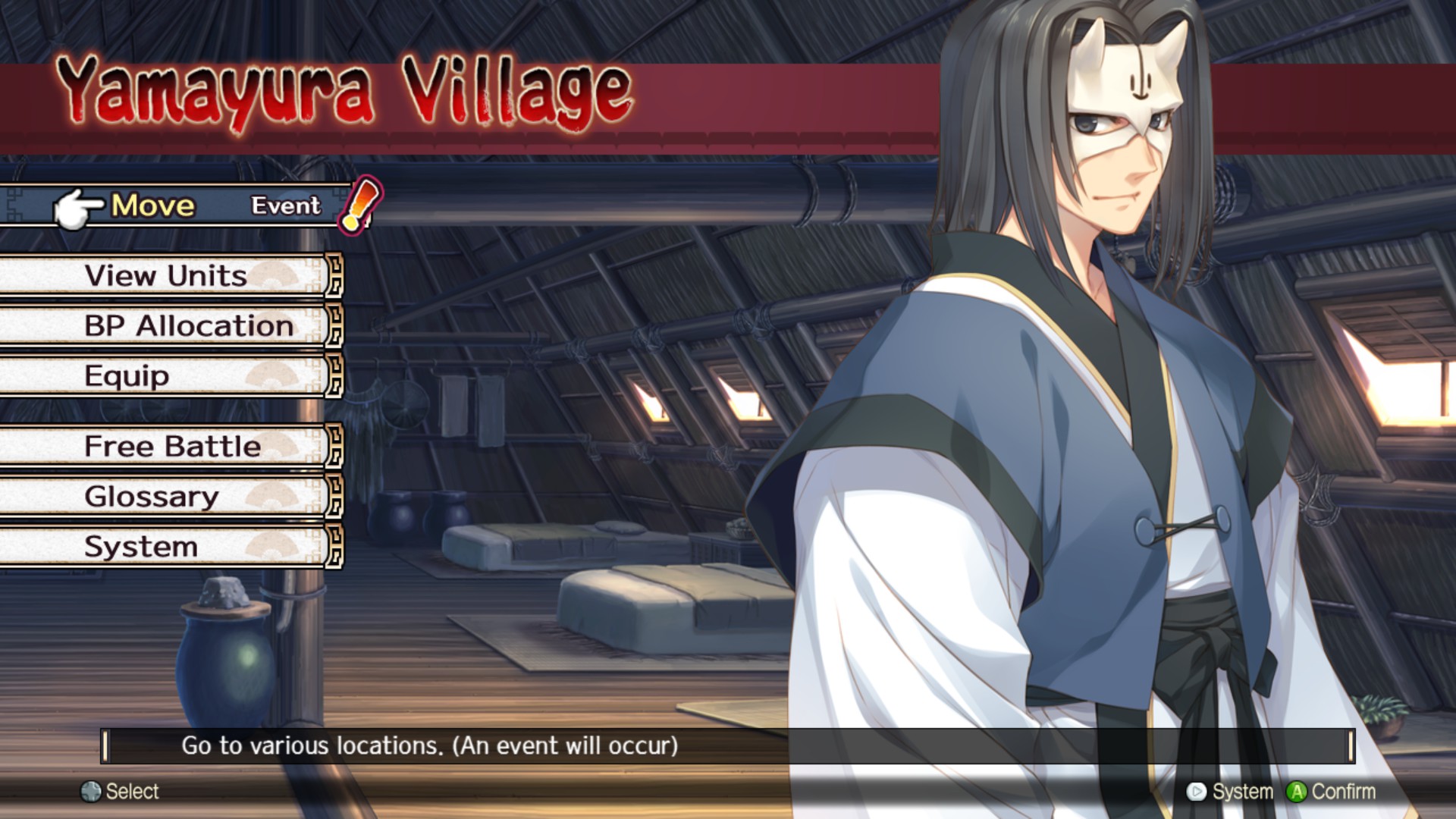
Utawarerumono is largely linear, with the only choices you can make being scene choices. Some plotlines tend to happen in particular places, such as the “field” having all the plotline having to do with how Hakuowlo helped the villagers cultivate a new field for more food, but for the most part, since the same half-dozen locations are reused for every event in the game, there’s basically no telegraphing which location is going to result in what scene playing out, and this really is sometimes a choice, as you can permanently miss out on a couple of items if you don’t pick the right option blindly from this list, or more likely, savescum to make sure you see everything.
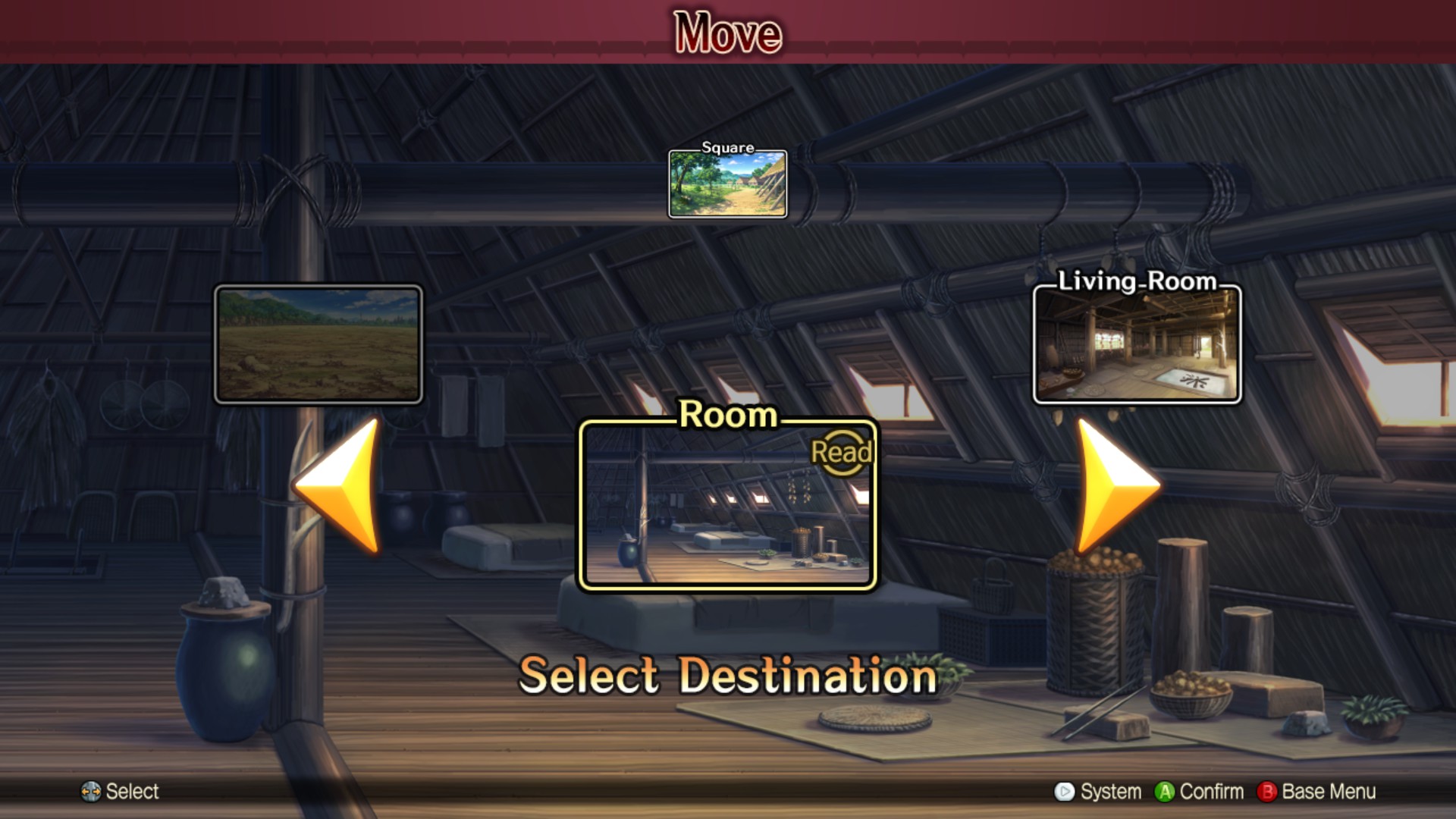
Note that while some scenes are missable because of this system, there are no real branches in the story. The missable portions are simply not important to the plot, although they can reveal extra content.
Combat
Combat in Utawarerumono is most similar to games like Fire Emblem, in that characters only have one standard attack, although attacks come in chains where you can inflict more hits as you gain levels.
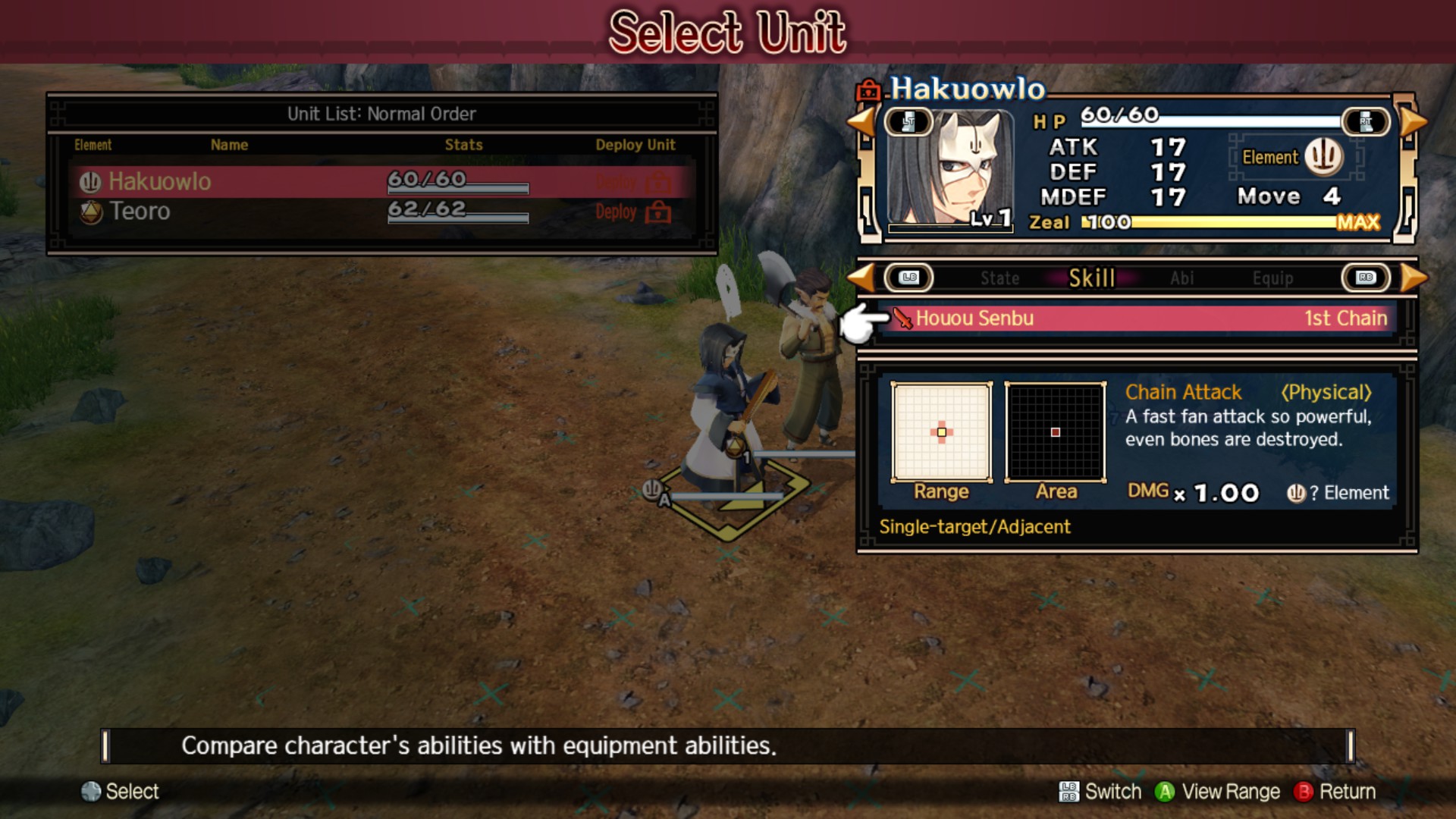
Attacking comes with a small timing mini-game, where hitting the “confirm” button with proper timing gives you a Zeal bonus.
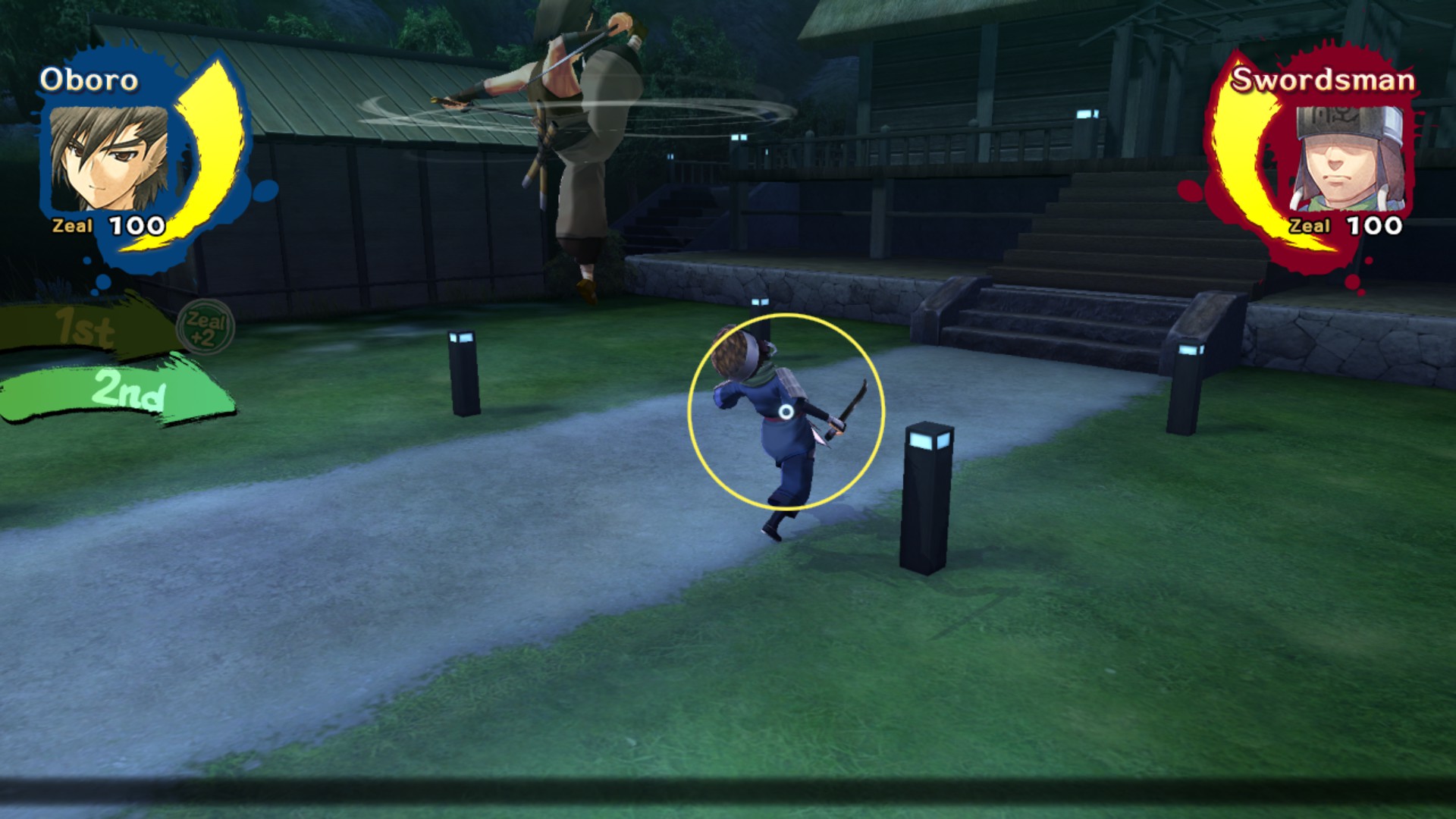
Failing in your timing does not actually result in inflicting less damage, but rather getting your timing right fills up the Zeal bar. A character gain 5 Zeal for every time that character takes an attack or makes an attack, but each hit in a chain you time correctly gives an additional +2 Zeal, which starts to outweigh the basic 5 Zeal from making an attack when you get 3 or more hits in a combo.
Zeal is used in many passive skills, including Hakuowlo’s special passive that allows him to revive if defeated while at 100 Zeal, which can be clutch since you get a game over if he is killed. The main use of Zeal, however, is that it gives you an extra hit in your chain for more damage, and if you have unlocked every attack in your chain, this means a “Final Strike” that comes with a short cutscene.
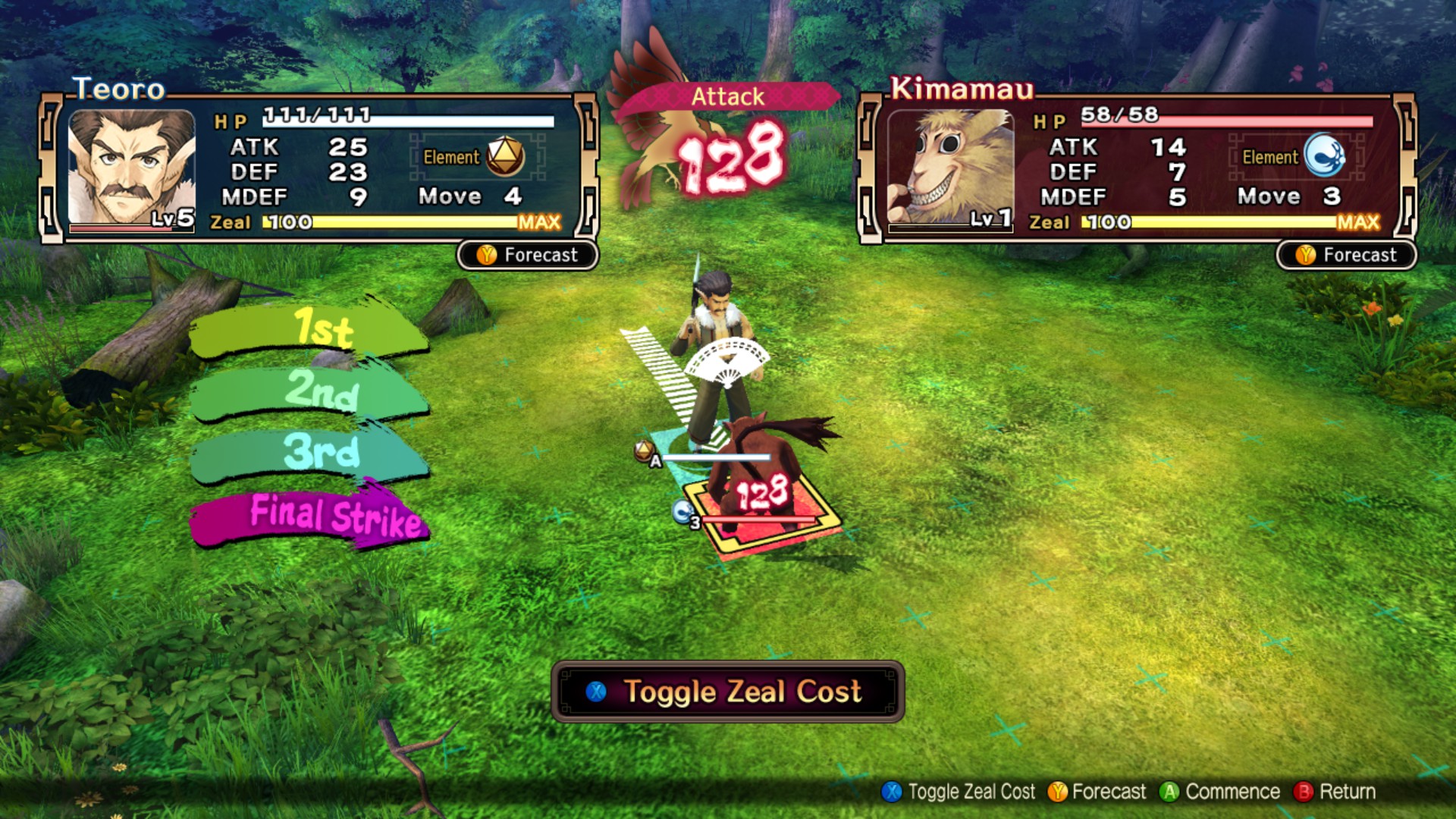
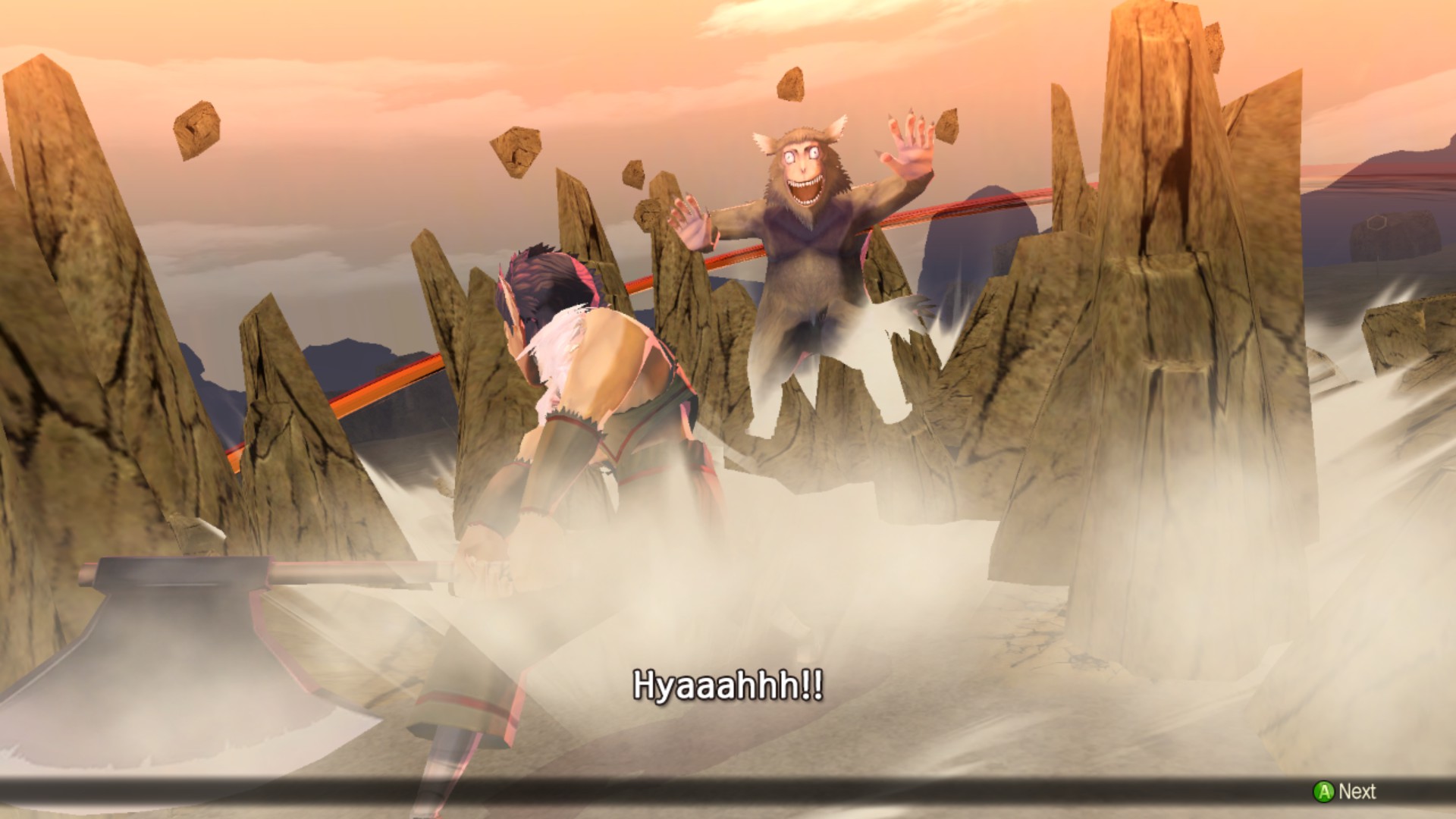
“Co-op chains” are similar to a multi-character final strike that are particular to characters who have a plot-relevant relationship with one another, and often allow for large amounts of damage to a large area of effect, making them particularly potent abilities to unleash on groups of harder enemies.
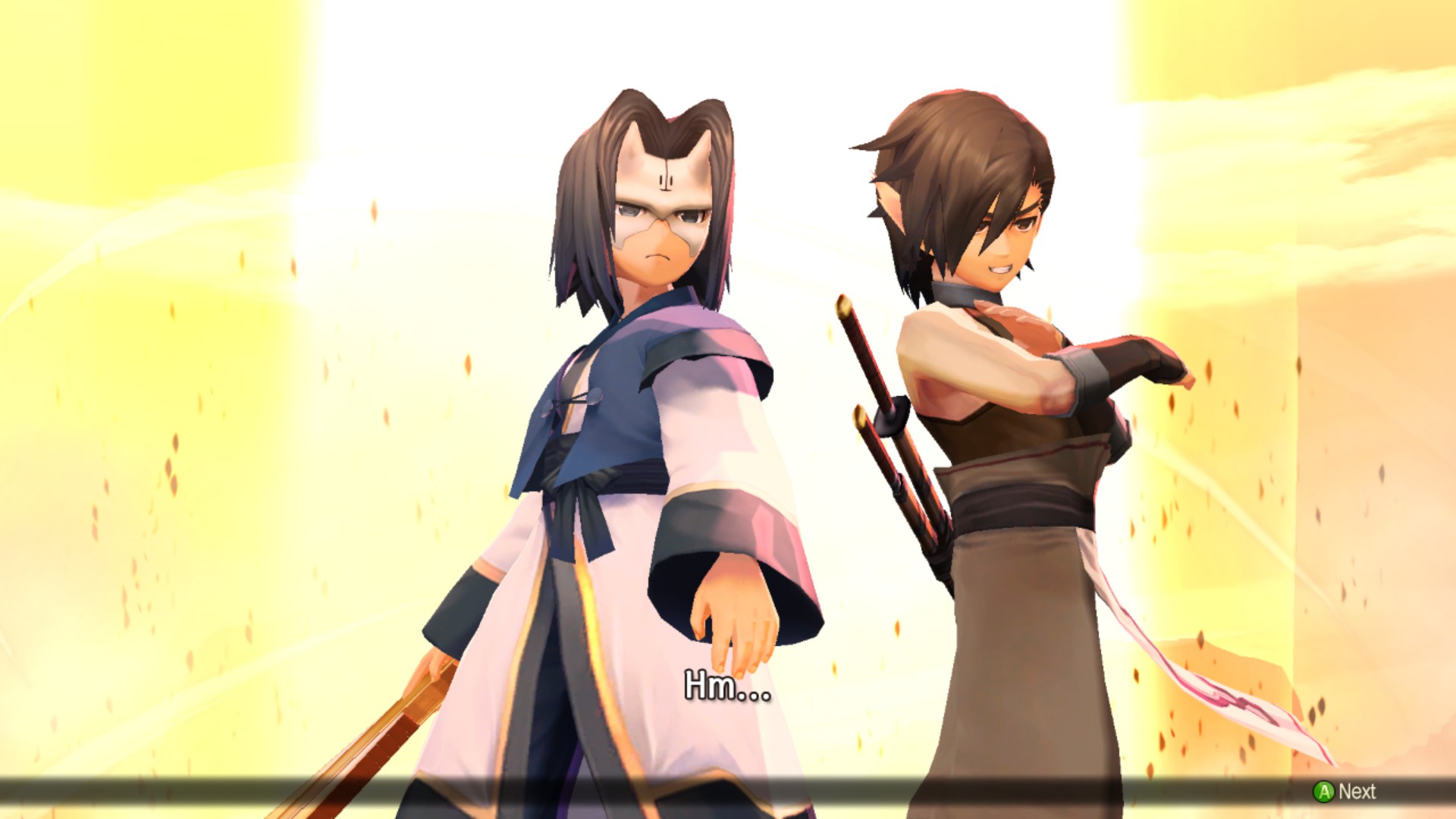
As you may have noticed from the screenshots, there are few attributes listed for each character. HP goes up with level, but the other three, consisting of attack, physical defense, and magic defense, only increase with BP gained at the end of battles the character participates in. (EXP can be gained by characters benched for a battle, but BP is only gained by participants.) Although characters have their own turns, and some characters seem faster/get their turns more often than others, no displayed stat is responsible for that.
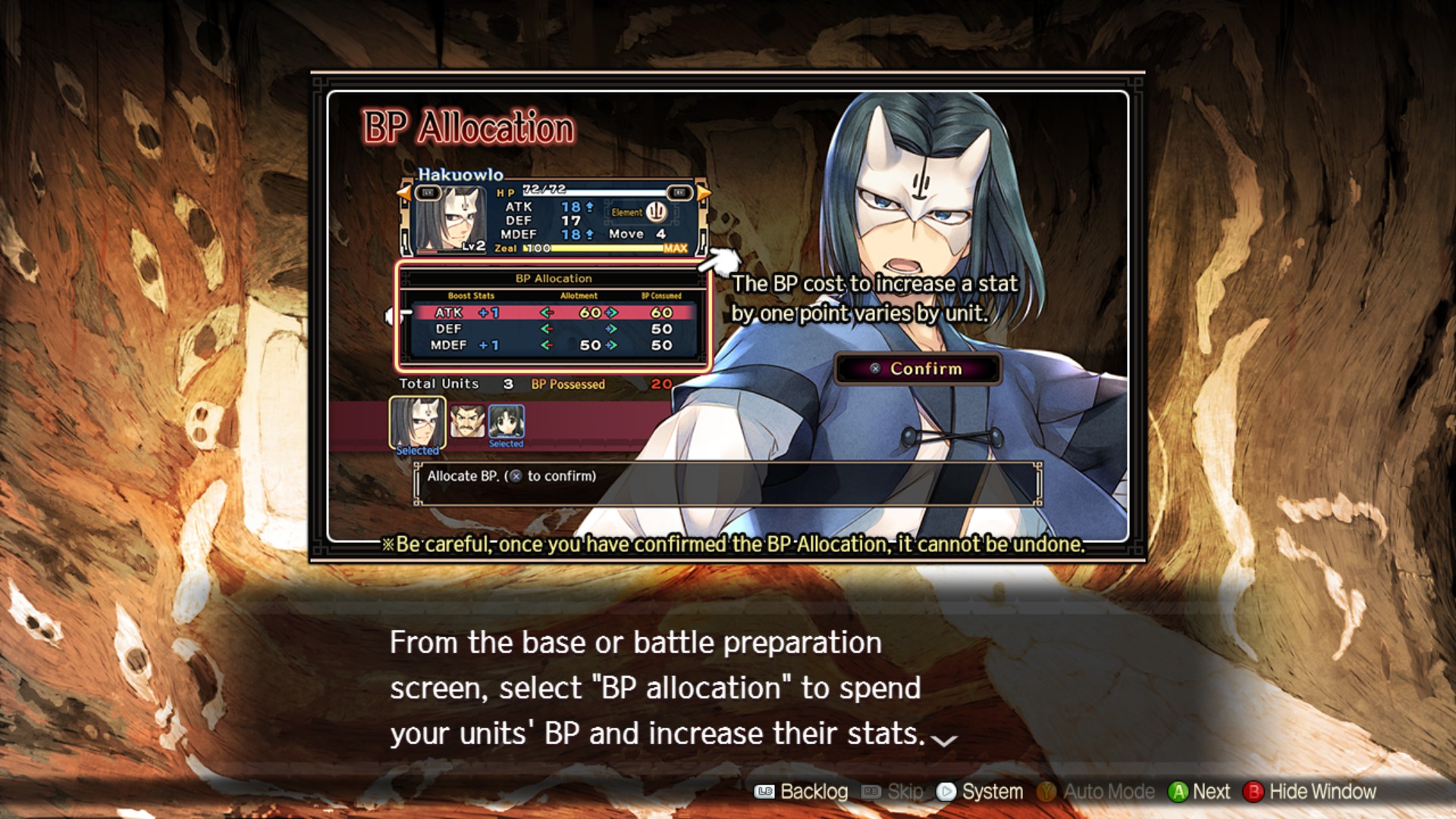
Additionally, healer characters like main female lead Eruruu have no attack abilities or even an “attack” stat, but a “heal” stat, instead. Like some Fire Emblem games, healers can only heal (and only heal others), and mages can only use magic attacks, although they have no MP limitations or weapon durability.
There are, however, some special skills that are usable only a limited number of times per battle or ability-granting items in the game that allow for some variety of moves. Eruruu, for example, gains a special ability to cure status ailments or boost attack power early on, and a ring you gain early on gives a character a static-power single-target ranged fire attack. Consumable healing items also provide a back-up means of healing, especially for the healer units.
Tactics
At the start of the game, you’re given a choice between Normal and Hard difficulty, although you can change this at any point before a battle during the game. There are no achievements locked behind Hard, so you can feel free to drop it from Hard for any battle that gives you difficulty if you start out on Hard.
Like many “Tactics” JRPGs, Utawarerumono has a facing mechanic, and rewards attacking from the sides with 1.25 times damage and the rear with 1.5 times normal damage. Actively pursuing this, however, can be a trap.
In my first battle (which was played on Hard), I actually lost because I attacked aggressively, trying to eliminate enemies quickly with the two units given to me, only to realize a bit late that Eruruu enters the battle in a cutscene several turns in, after I’d already gotten stuck in the fray. Because I couldn’t pull Hakuowlo back before getting mobbed further (the enemy focused all attacks on him), it was a Game Over.
Lesson thus learned, I quickly discovered the true nature of Utawarerumono’s tactical gameplay: This is a defensive game. Your healers can recover massive damage per turn, but cannot heal themselves and are very vulnerable, so the best way to proceed is to keep your healers safe at all times and work on keeping healed and grind your enemies down with attrition rather than aggressively eliminating enemies quickly, even if enemies can heal, themselves.
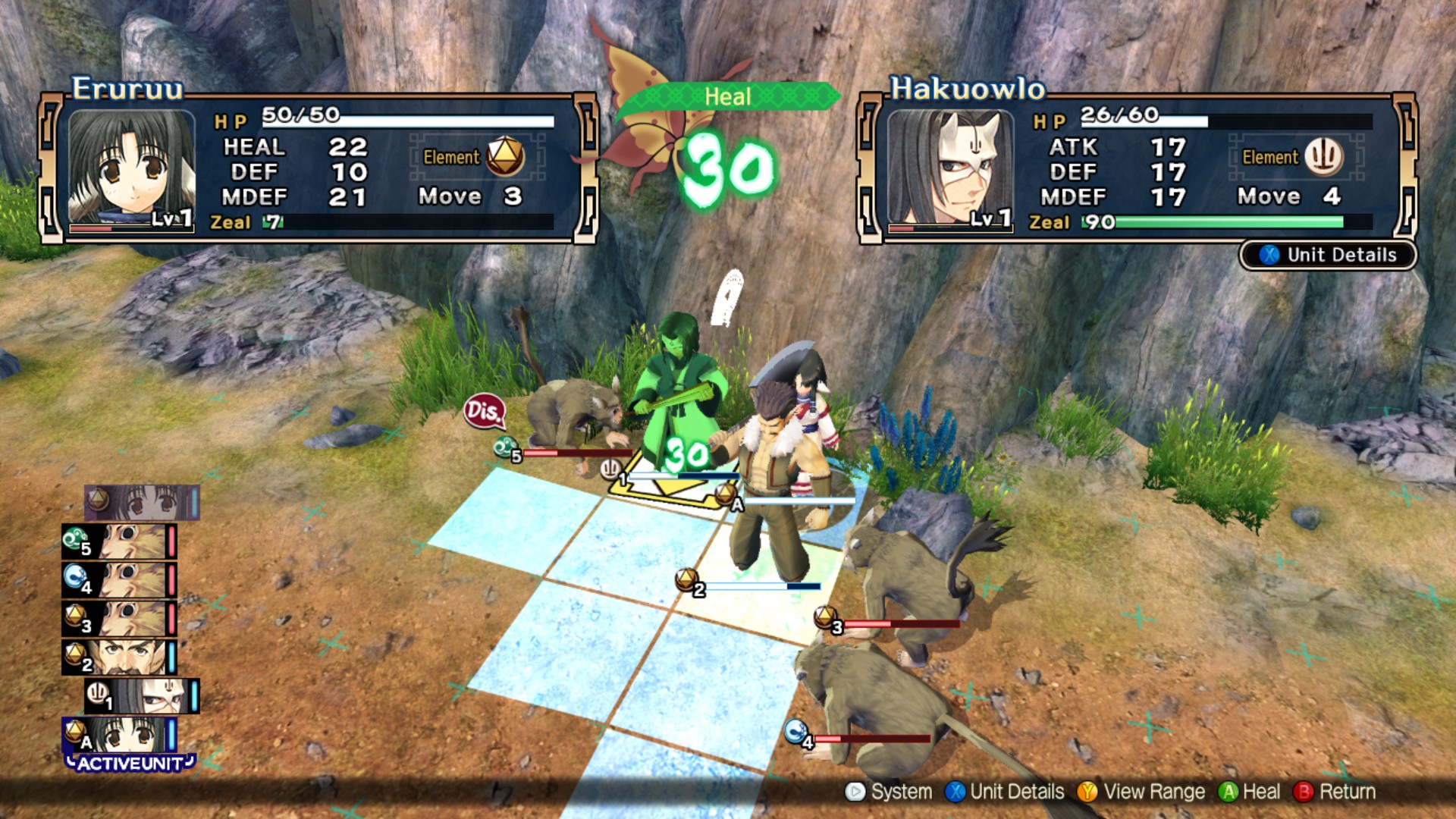
Unlike games like Final Fantasy Tactics, there are no bonuses to a character’s next turn if they do not use their main action for a turn, so staying out of range of an enemy’s attack radius is a highly effective way to lower the amount of damage you are taking and give your healer more time to patch your characters up. You can additionally move after attacking in Utawarerumono, so feel free to attack then retreat so enemies cannot find a way around your front lines, or let archers shoot then reposition so melee enemies never get an attack.
Another interesting feature is that the “prediction” of how much damage a character will deal with an attack is always accurate, even to the point of “predicting” whether a skill like one that blocks ranged attacks a certain percentage of the time will take effect. Obviously, you shouldn’t bother shooting a target that will take 0 damage.
Adding to this, there is also a notable feature in the “Rewind” function, and a rolling set of 10 autosaves that are filled with every character’s turn. Rewind in particular lets you go back up to 50 moves in the past without needing to reload at all. The die rolls seem to be predetermined, so you can’t just savescum your way to victory through luck, although the rewind ability absolutely lets you keep trying every iteration until you can find success. Even on Hard, however, I’ve never found a battle actually difficult enough to need to use it to win, and battles tend to get easier as you go along, as you steadily gain experience and can pump BP into stats to make your characters shrug off the enemy’s attacks. Even doing a couple free battles here and there is enough to overpower enemies for most of the game.
Story and Writing Style
I’ll do my best not to spoil the plot any more than the Steam store page already spoils, but Utawarerumono is a game focused upon a fantasy version of Ainu culture. The Ainu are/were an indigenous ethnic group that lived in what is now northern Japan that was distinct from Japan until they were conquered and forcibly integrated only in the past couple centuries with their own distinct language and traditions. This is the reason why Utawarerumono’s characters have names that sound strange even if you’re used to Japanese names, and the characters also are dressed in traditional Ainu garb.
The game starts with main character Hakuowlo waking up from having sustained grievous injuries and with no memories of his past, although he has a strangely modern understanding of science he can share with the simple rural villagers. He’s nursed back to health by main female lead and primary romantic interest Eruruu and her grandmother Tuskur, only to be surprised by how he’s now living in the land of cat- err… dog(?)girls. He also has a strange mask apparently fused to his face with no way to remove it.
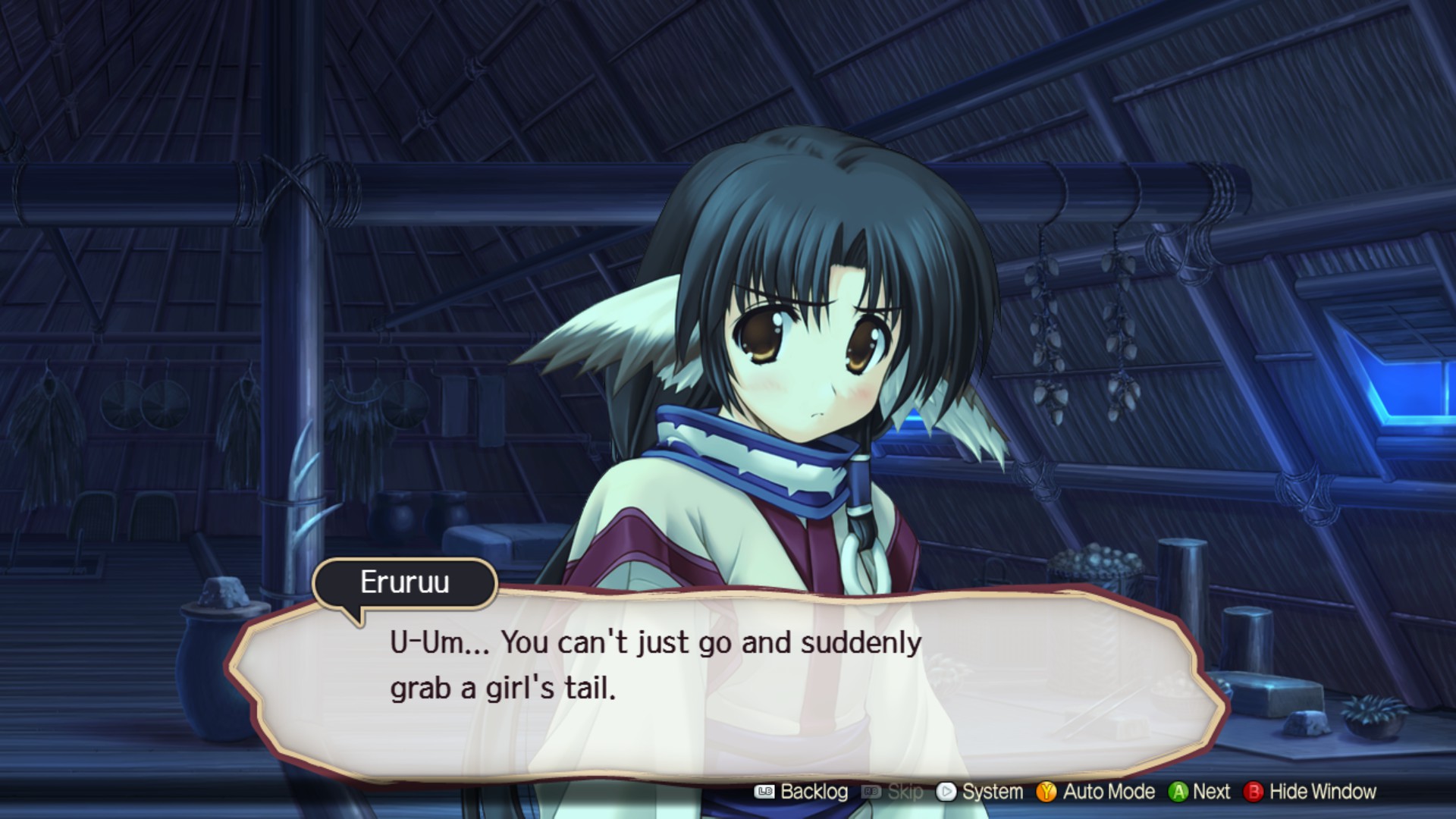
Using his knowledge of things like the macronutrients and micronutrients that plants need in the soil or how to smelt steel, Hakuowlo allows the village he woke up in to quickly start to grow, and even absorb refugees from the wars taking place elsewhere. This eventually lands the village in trouble, however, as the growing and increasingly wealthy village attracts the attention of the corrupt noblemen that rule the land, and events soon conspire to push Hakuowlo to lead his new home into open rebellion against the ruler of its kingdom and conflicts beyond.
In the grand tradition of such games, tension-raising twists need to be revealed that become increasingly dramatic to keep the viewer invested, and for a game with a story this long, that means stakes need to keep being raised to ridiculous degrees. Much about the fantastical feudal setting and most character’s apparent backgrounds winds up being revealed as having one twist to it or another that can get towards a total genre shift at times. This doesn’t reach “the whole world was a VR simulation all along” levels like some RPGs, but some reveals will raise more questions than they answer.
Many scenes are played in a specific order, but as previously mentioned, the game frequently goes back to a “headquarters” screen where you can take on free battles or advance the plot, and when advancing the plot, there are often choices. Sometimes, you can only see one scene out of your options, and other times you have to see all of them, while you just pick the order. Regardless, this winds up meaning that there are multiple plot threads that often are segregated into their own scenes with their own cliques of characters that plot thread involves, so that you only need to watch that one plot thread in order. This can, however, result in sudden mood shifts as you pass from a calm village life plot thread to a dramatic feudal politics plot thread from scene to scene.
One problem I have is that lines can often be repeated in ways that approach self-parody. I remember reading about one visual novel’s translation team stating that they had cut about 1/3rd of a game’s dialogue because the visual novel had so much redundant text that followed up something a character said with a text description of what it just said. While Utawarerumono isn’t nearly that bad (unless the translators trimmed this game, too), you’ll find a series of lines such as one early on where Hakuowlo, after going to bed says, “I am getting so sleepy.” “I should go to sleep because I am so sleepy.” “Yes, sleep will cure my sleepiness.” “Sleep is the activity in which I’m about to engage.”
Considering the game has stretches of visual novel parts that go on for about an hour between gameplay parts, if you’re itching for action, it can really test your patience to have repetitive dialogue that doesn’t seem to be advancing the story in any way.
Similarly, the game likes to use screen filters and monochrome effects whenever Hakuowlo thinks back to something someone else said previously… even if it was said only 20 seconds ago in the same exact scene.
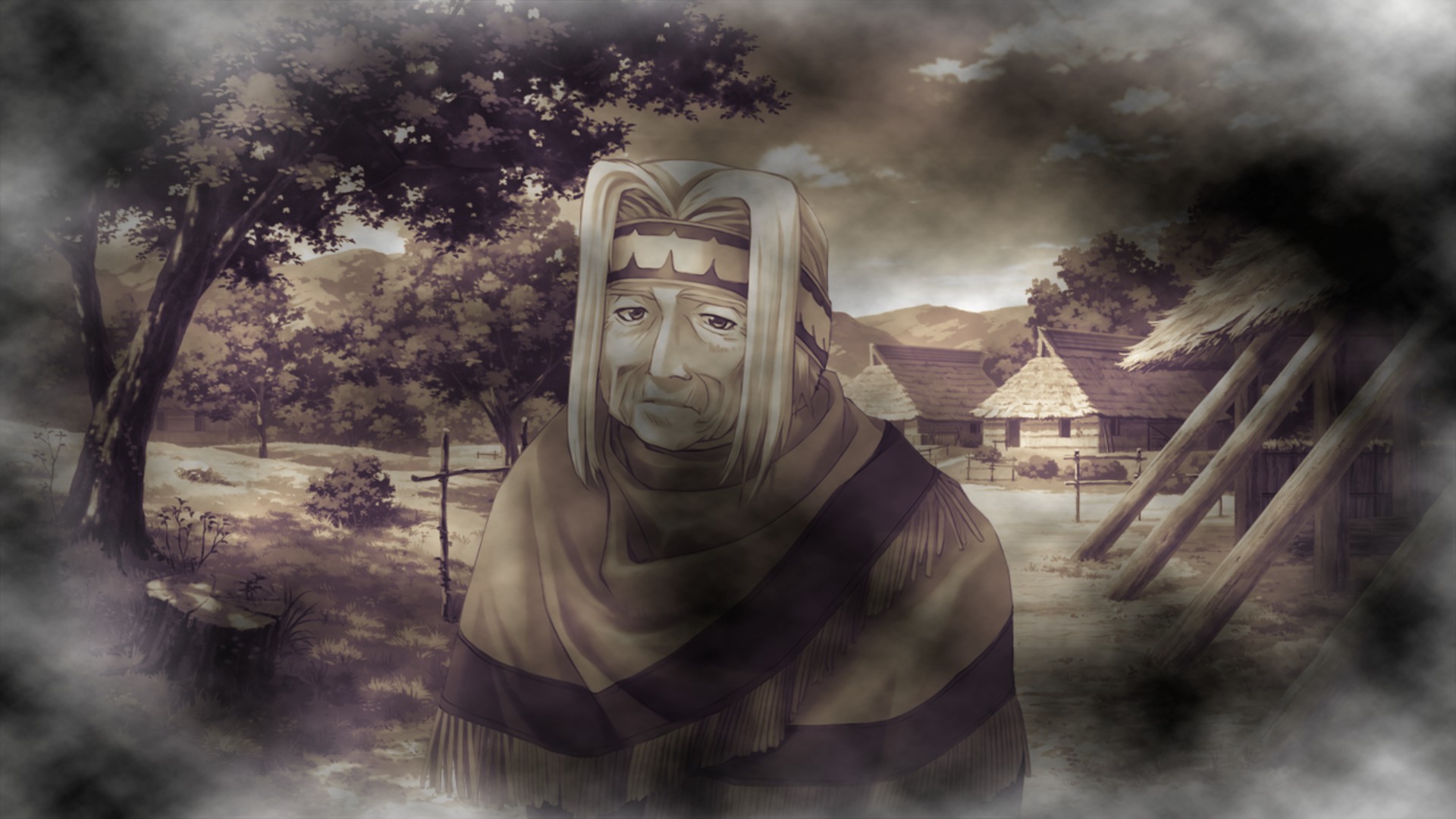
Main Characters
Three characters stand out as the main characters of the story, to the point they tend to be front and center on all the marketing material about the game, and those are Hakuowlo, Eruruu, and her younger sister Aruruu.
Following the long tradition of harem protagonists, Hakuowlo’s skull is protected by a thick layer of Protagonite, the densest material known to fiction, and completely impervious to even the most blatant signs of romantic interests being in love until the plot says it’s time to tie off the romantic loose ends.
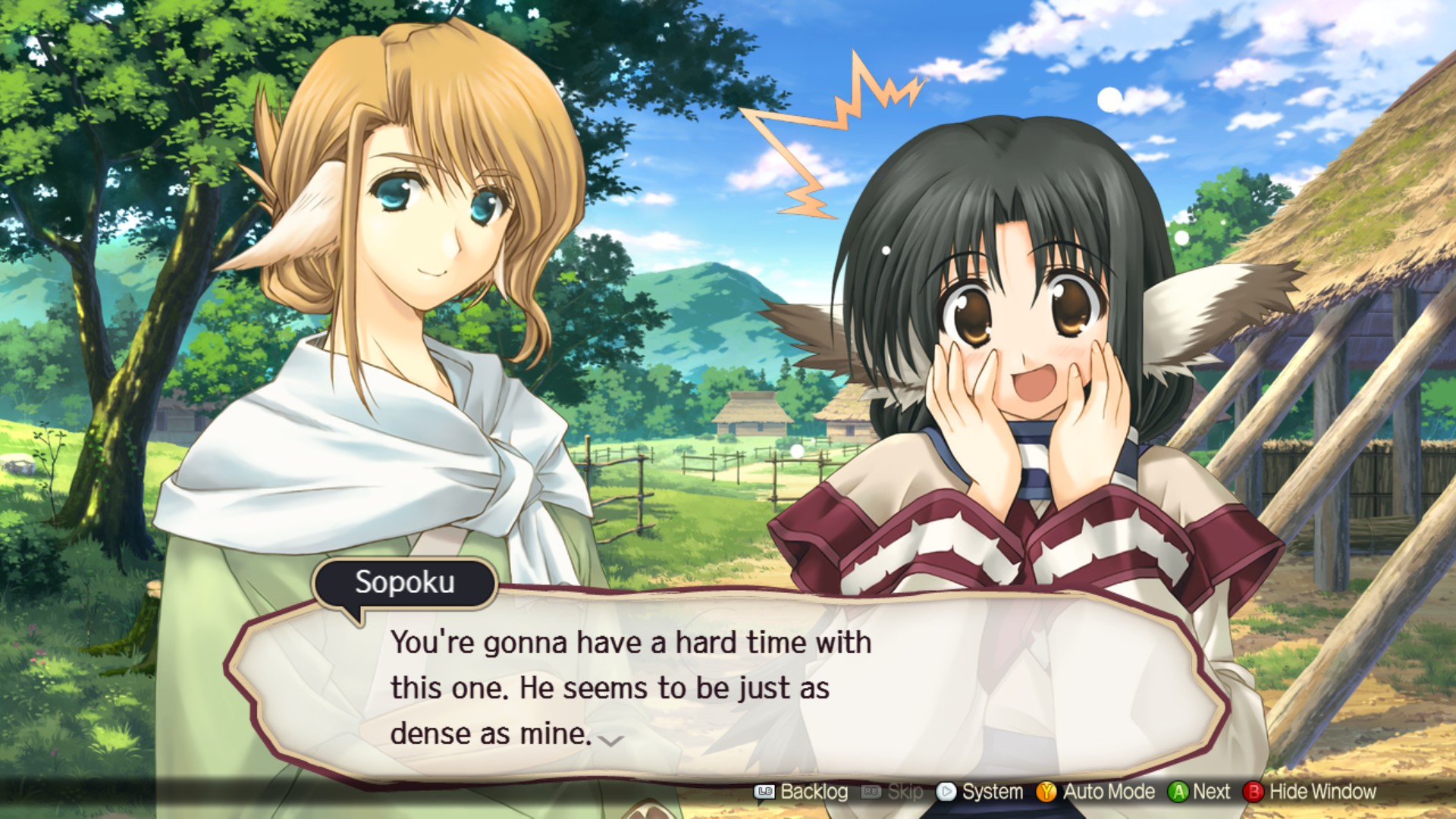
In Hakuowlo’s case, it seems to go beyond merely rendering him incapable of understanding this “love” emotion you humanoids speak about, but seems to indicate his brain damage goes beyond mere amnesia and into failure to understand basic human emotions without having people literally spell everything out for him. There are frequent cases of Hakuowlo failing to understand even the most obvious of emotional states of people around him.
Oboro: “How dare you touch my sister! Get out and don’t come back! I’ll kill you!”
Hakuowlo: “Hmm… he doesn’t want me to come back? I wonder why? Maybe he is feeling angry, but about what?”
Hakuowlo’s weapon, contrary to the traditional hero’s sword, is a war fan, a symbol in Japan of a genius strategist. Most of the story focuses upon how Hakuowlo can build a nation using his own cunning and wealth of knowledge that seems very out of place in this setting, so we’re clearly supposed to see this guy as a genius. This tends to get seriously undermined in tone when he fails to grasp even the most basic of human emotions and constantly needs people to tell him how to respond to obvious social cues, especially since the story doesn’t recognize him as a flawed genius in the style of something like Monk or Sherlock Holmes.
Eruruu, for her part, is a fairly traditional girly-girl main romantic interest. (This was from a time before all female leads were overt tsunderes.) The game’s character describes her as “sometimes getting extremely jealous”, but that tends to be less a character flaw and more Hakuowlo’s gleefully telling her about how he’s getting on with the other romantic interests for “comedic” purposes. Aside from her training as a medicine-woman, Eruruu is a fairly unremarkable female lead against which the rest of the crazy can be contrasted. Well, unremarkable except for one more thing, at least – when Eruruu’s grandmother finds out Hakuowlo has amnesia, she’s the one to name him Hakuowlo… after her dead son, and then gave the new Hakuowlo her dead son’s clothing, which definitely isn’t laying a serious emotional burden on someone barely capable of recognizing such things.
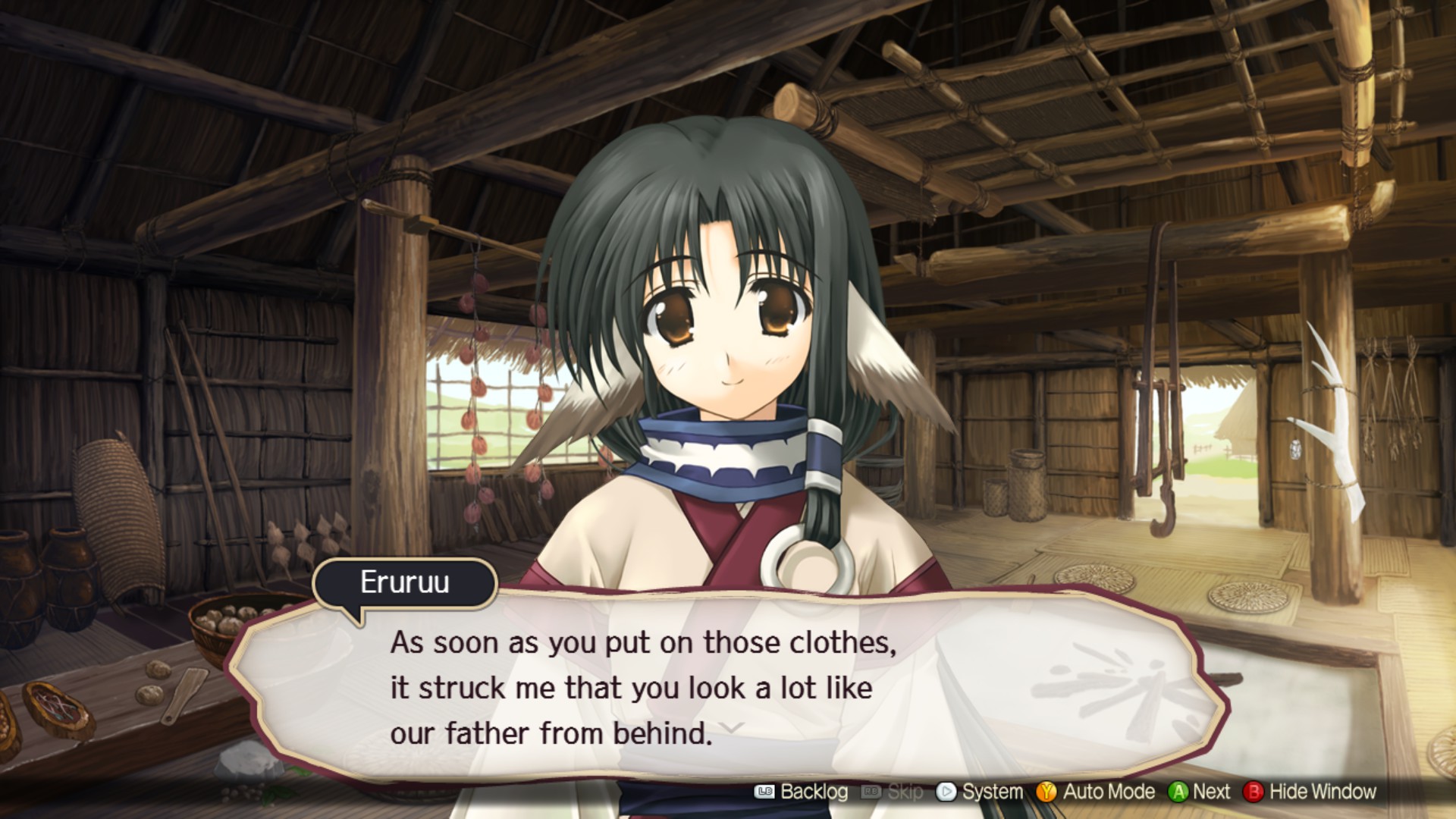
This makes the fact that, after hearing that Hakuowlo is named after Eruruu’s father, the entire village seems to immediately latch onto the idea that Eruruu is in love with Hakuowlo. You know, like there’s nothing creepy with associating a girl’s father (or even just any man old enough to be confused for her father) with a girl’s lover or future husband.
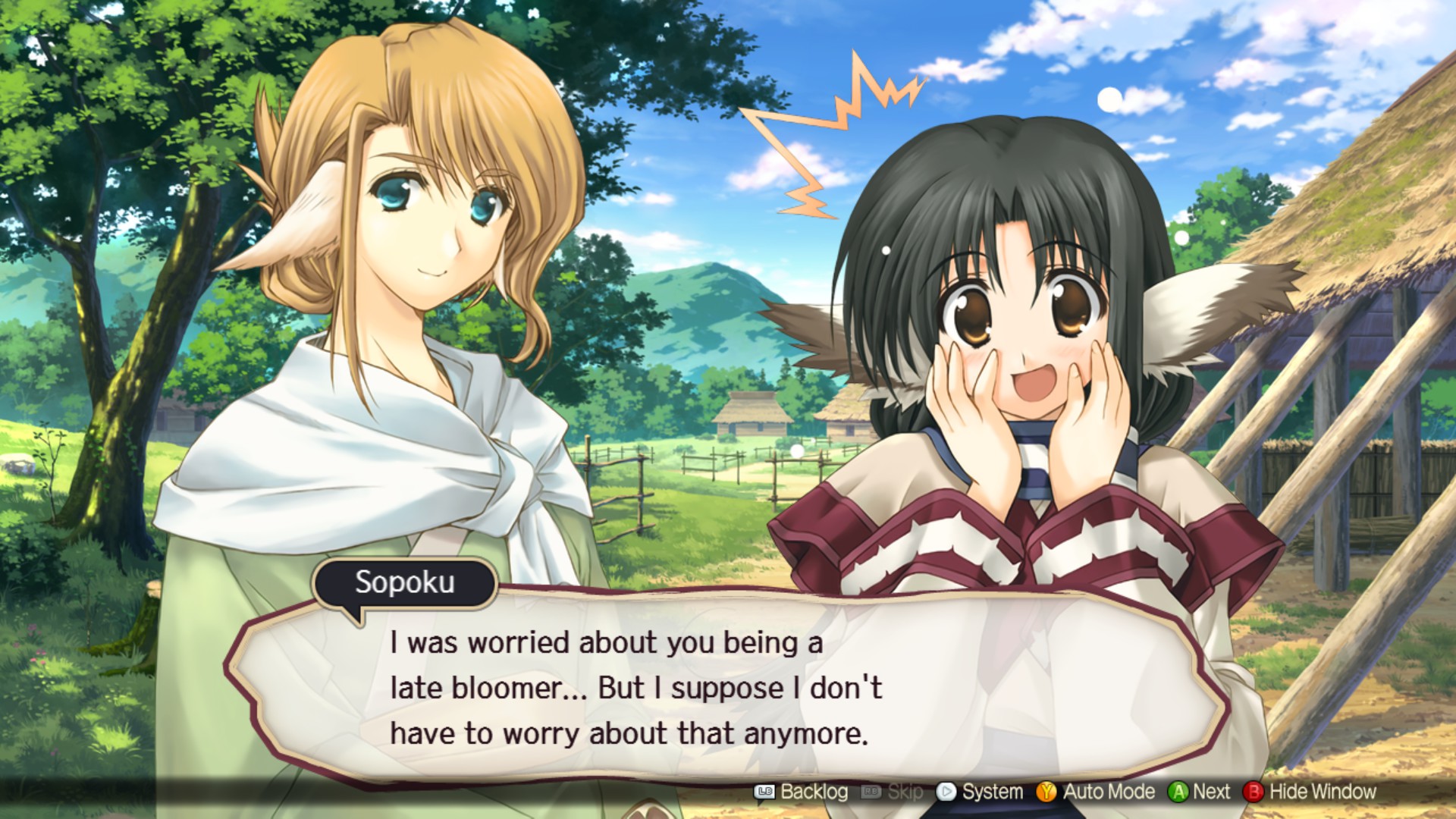
Eruruu is also far and away the obvious main romantic interest in the story. She has a roughly 2 hour head start in the story before any other romantic interest even shows up, and even when the others finally appear, she still gets far more screen time, lines, and plot importance, so even if there was branching story and romantic plotlines, Eruruu would still be the obvious favorite.
One recurring joke/source of conflict in the Hakuowlo/Eruruu romantic plot thread in fact revolves around Hakuowlo regarding both Eruruu and Aruruu as both being equally young girls, which doesn’t help the age difference squick any.
Aruruu, for her part, looks like she is maybe 10 and acts like she is maybe 4, and is mainly a comic relief character, although she’s also imperiled for dramatic moments. Aruruu is at times referred to like she’s around Eruruu’s age, but their apparent emotional ages could hardly be more different. Aruruu is treated by the text as a very shy girl who doesn’t open up to too many people, but she is probably the only one of these animal-ear people that outright acts almost exactly like an animal. In most of her scenes, she behaves on instinct without any forethought for the ramifications of her actions, motivated almost entirely by food and running from her sister trying to get her to act like a human. The remainder of her scenes, she latches onto the notion that Hakuowlo is her (surrogate) father to an absurd degree, calling him “Daaady” and snuggling up to get pet all the time. (She’s the main reason why I lean more towards considering the animal-ear people dog-people, because Aruruu acts so much like a puppy.)
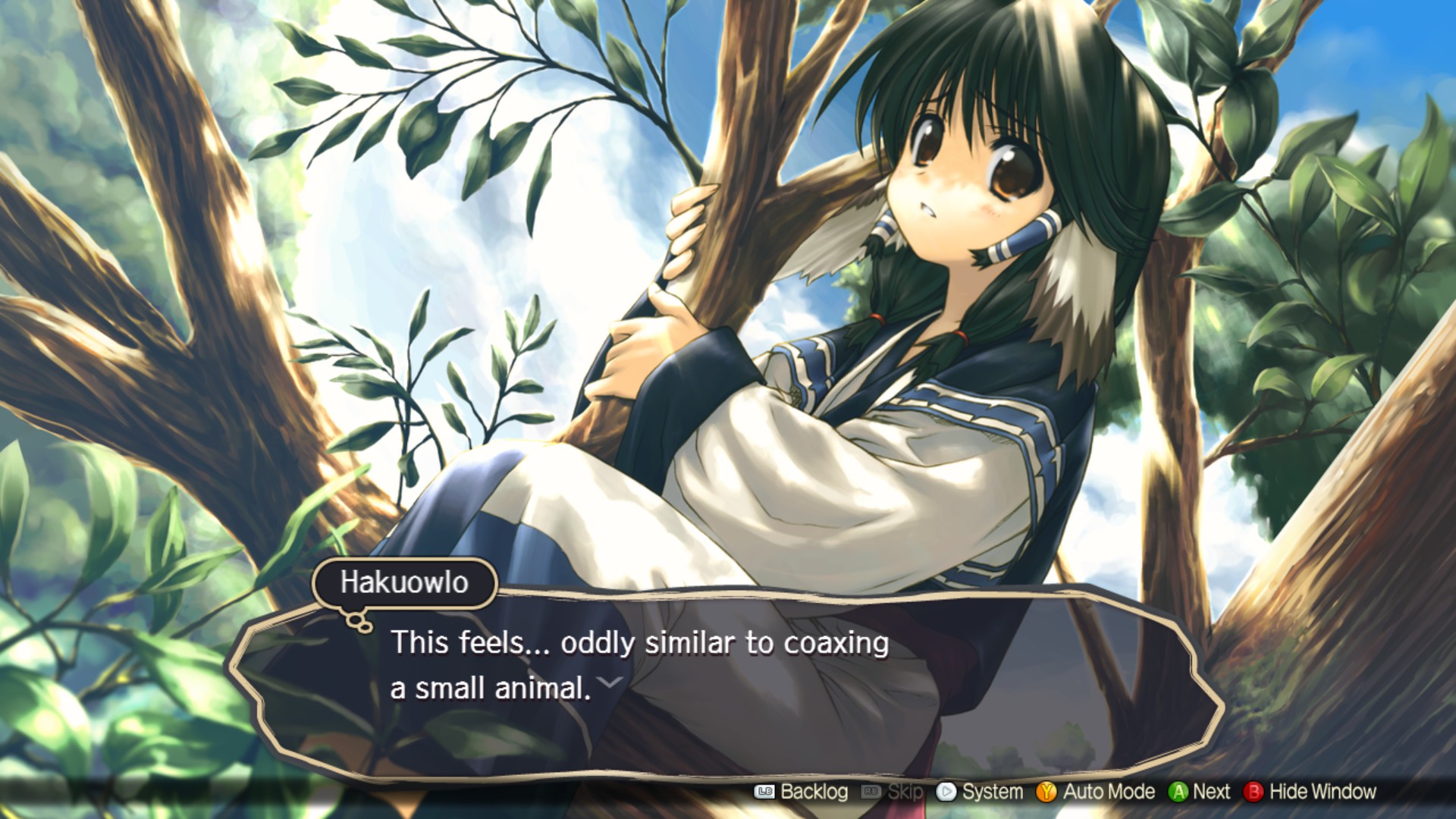
The archetype that Utawarerumono’s writers were clearly aiming for with Aruruu was the mysterious, silent girl. The problem is that there’s this fine line between making a character’s silence feel like it masks complex thoughts going on underneath and making a character’s silence feel like it’s because there are no thoughts going on underneath, and Aruruu’s writing goes sailing merrily over that line. Mysterious deadpan little girl characters like Hoshino Ruri (of Martian Successor Nadeshiko) manage to achieve the former because they occasionally break their silence with incisive insight on other characters. Aruruu only breaks her silence to mewl for Daaaddy or get herself in trouble with her big sister/surrogate mother.
Villains and Tone
The major recurring characters, while flawed, are at least lovable enough that you can overlook the flaws in service to the story.
The villains (not antagonists, villains), however, do active harm to the story and its intended effect. One commenter said they got turned off by the game as soon as they saw the villain lineup.
The first humanoid villain Nuwangi is not great, but not terrible. (The game starts you off with some wild animal antagonists, whose characterization is all you’d expect of them.) He’s the son of a major noble who talks like a stereotypical anime street thug that exists just to get beaten by the hero. He’s basically the stereotypical incel who has a crush on Eruruu, but doesn’t understand why breaking his hand trying to punch the guy she likes, ordering soldiers to beat up her friends, or raising taxes on the town until the farmers face starvation isn’t making her like him more.
This guy manages to have the Draco Malfoy problem of being such a pathetic butt monkey that so constantly gets upstaged you can’t take him seriously even when he’s about to be the inciting incident for the whole rest of the plot. They’re trying to do the big tragic moment, and I’m still giggling at how over-the-top pathetic they’ve made this kid.
However, Nuwangi is still a character they gave some pathos and human emotion to because he had screentime to develop a little. The next villain, his father, is on screen for only about 10 minutes, so they can’t bother with humanoid emotions. Therefore, they just make him look like this:
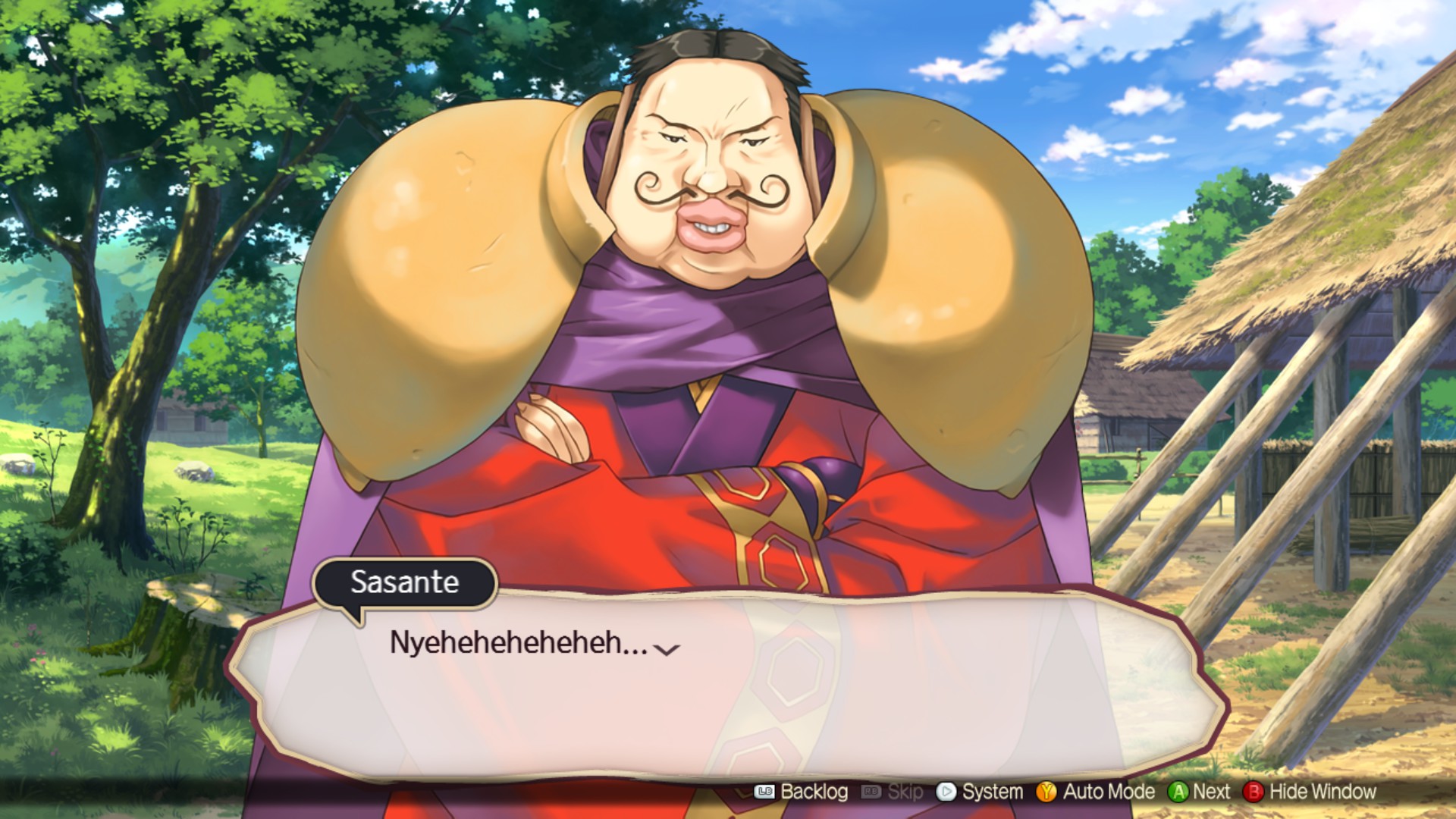
Again, they’re trying to make this guy seem terrible and evil, and he’s just hilarious. This guy is Waluigi. He’s so cartoonishly over-the-top slimy in every way that you have to love him. This guy is a boss fight, and his standard attack is to throw one of those cartoon black sphere with a fuse bombs at people, then spray poison in their face, then stab them with hidden sleeve blades, then hose them down with a flame thrower. The whole “tense battle”, I was laughing uproariously.
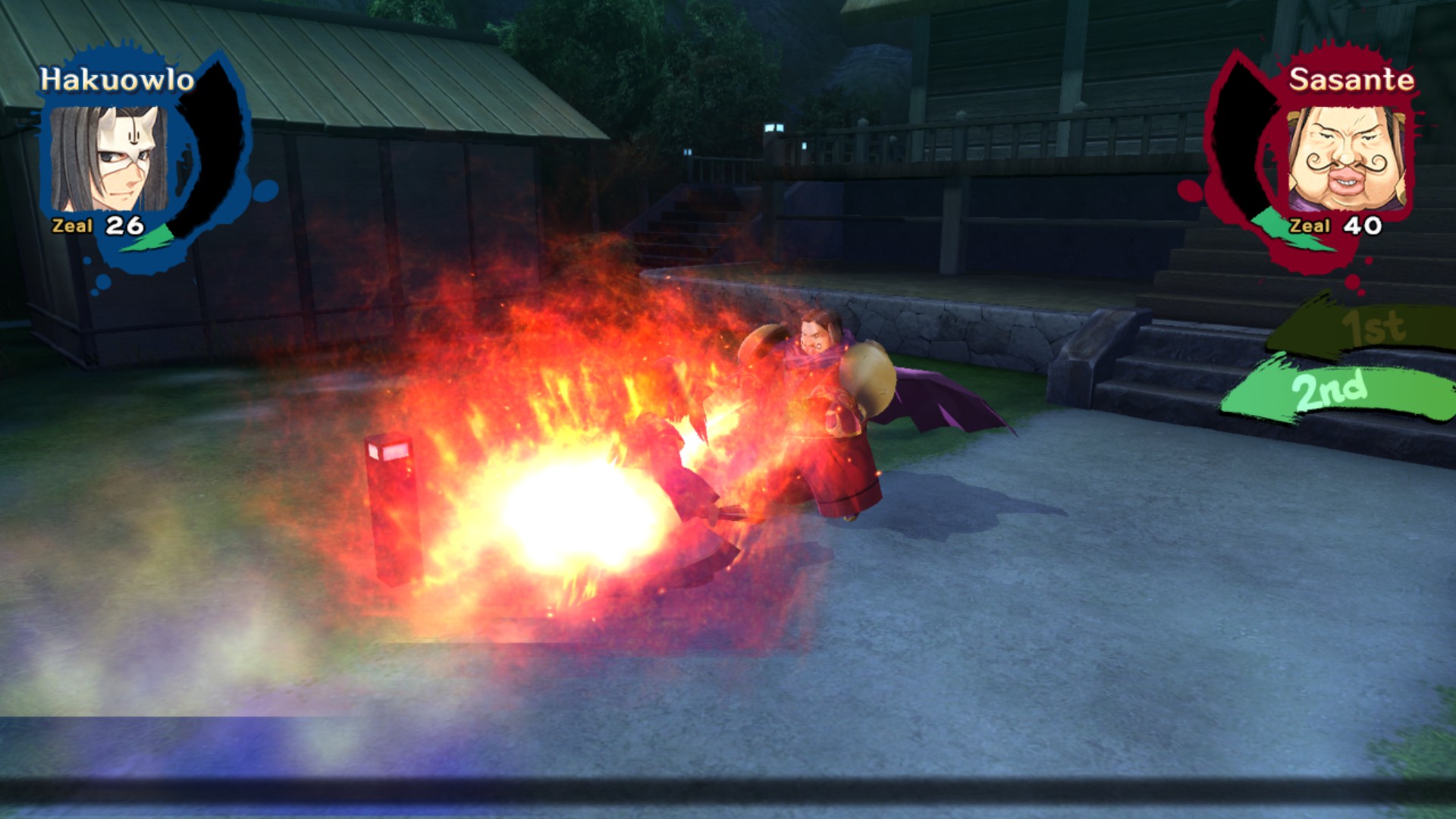
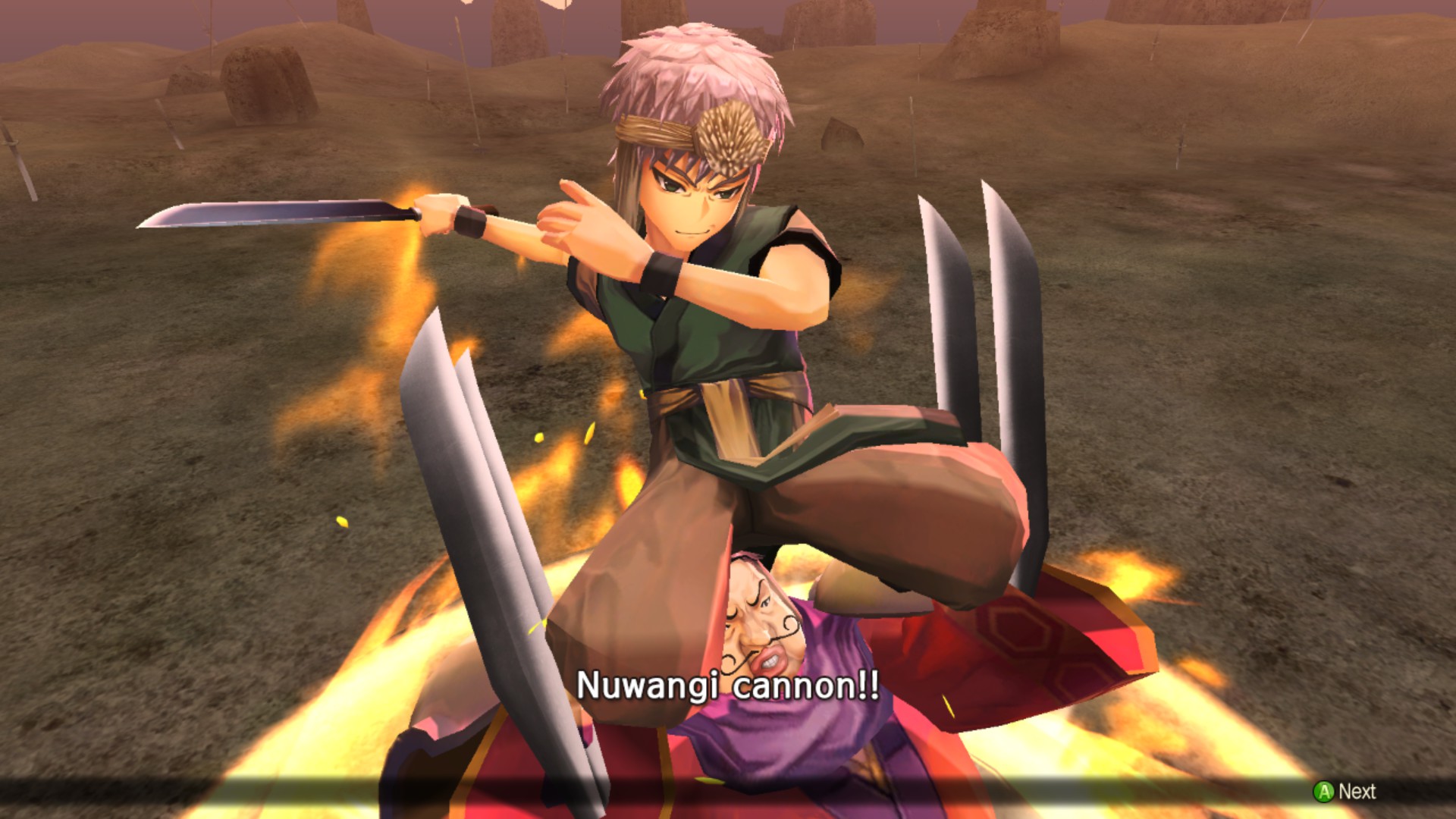
But then, they bring out the emperor to replace that guy as main villain.
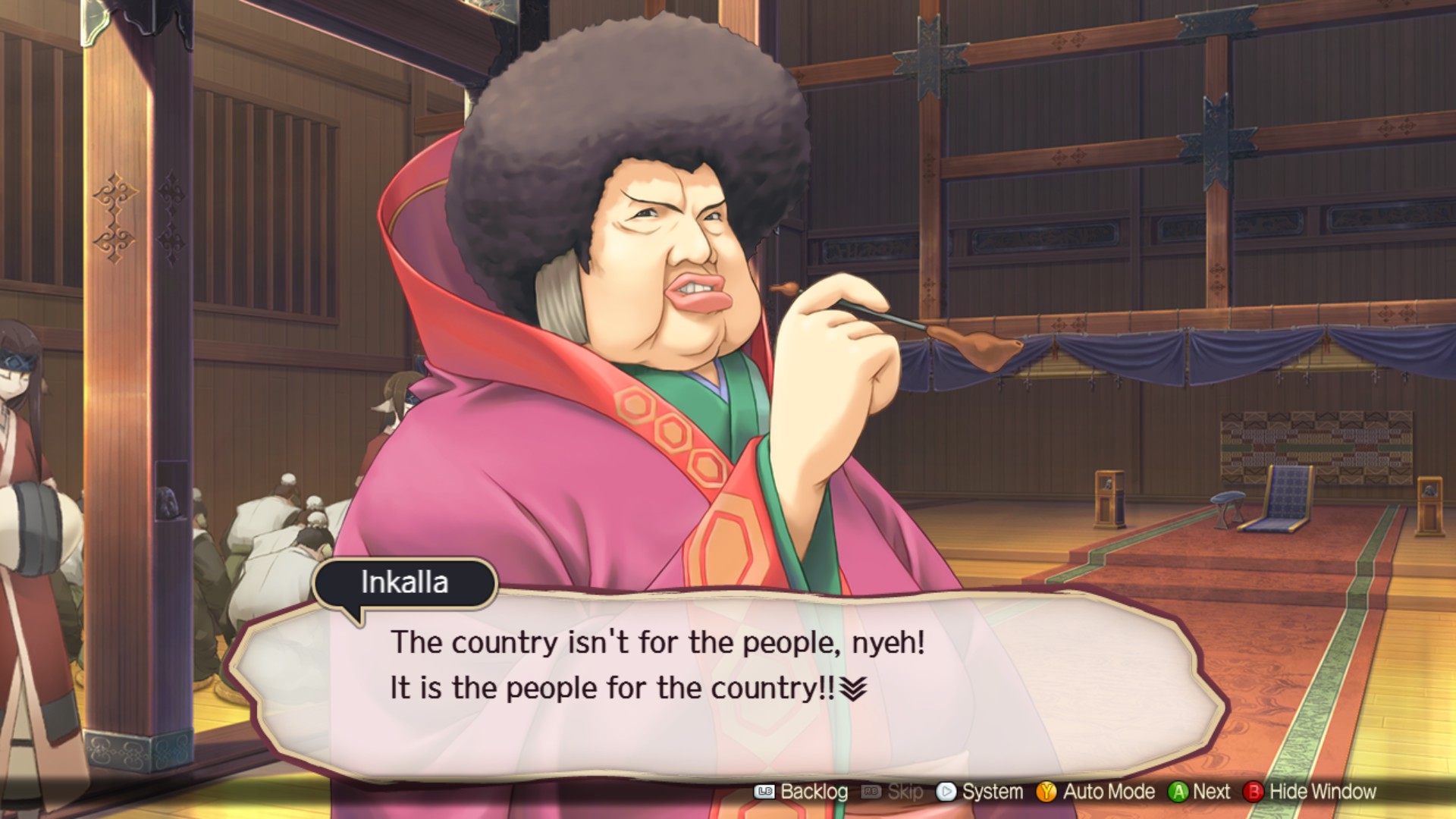
At this point in the plot, they’re clearly trying to make a plot with a tone like Game of Thrones with shifting loyalties and people making desperate choices because they are in desperate positions, but this guy is like if they replaced Cirsei Lannister with Raul Julia’s M. Bison from the Street Fighter movie. This guy chews the scenery like he hasn’t eaten in a week. They try to play him up as sinister and villainous, but he makes any scene he’s in a total joke because he’s a total joke, and he makes anyone who talks to him seem like a total joke because of that.
There’s this hypocritical trend in anime, where they never let anyone but dangerous extremists or dangerously naive false heroes ever talk about their own actions as “just”. Only in shows for the youngest of kids do heroes talk about “upholding justice”. Of course, they still do want their heroes to uphold justice, but they have to put on the show of how they’re actually acting selfishly because they wouldn’t dare do anything as childish as have their heroes do the right thing just because it’s the right thing to do. This is why Goku will shout that he’s stopping the villain because while sure, he’s committed genocide and is actively trying to destroy the world, the real reason he’s mad is because he killed Krillin, they guy who gets killed and resurrected every other week!
The royal army is led by a man you can tell right away is a noble person torn between his duty and what is right because he’s not drawn like a human-shaped pig and doesn’t speak like the writers obviously hated this character and wanted you to hate him to. He confronts Hakuowlo while standing in a burning village asking if Hakuowlo thinks if his rebellion is truly just, and Hakuowlo, as an anime character, acts pained and indirectly says no, even though it angers his troops to concede this point. After all, only a children’s cartoon character would be naive and simple-minded enough to say that yes, their cause is “just”! He’s a man who’s allowing innocent people to die in this rebellion, so his cause can’t be claimed to be just!
The problem with having that kind of pathos is that the villain of this story arc IS a card-carrying children’s cartoon villain. That discussion took place in a village that was burned down by the emperor even though it hadn’t joined the rebellion because he honestly didn’t bother to check whether it was part of the rebellion or not before killing everyone in it, since why would it matter, anyway? In fact, the reason this guy caused the situation where the rebellion could foment in the first place is because he spent so much money on hair care products to give himself a big afro in spite of being Japanese that he literally bankrupted the kingdom and has to tax the kingdom to starvation to pay for hair product. I have to reiterate this because it’s the dumbest plot point I’ve seen yet – the entire rebellion that kicks off the game’s plot exists because the emperor spent a significant proportion of an entire kingdom’s budget just on his own personal hair products.
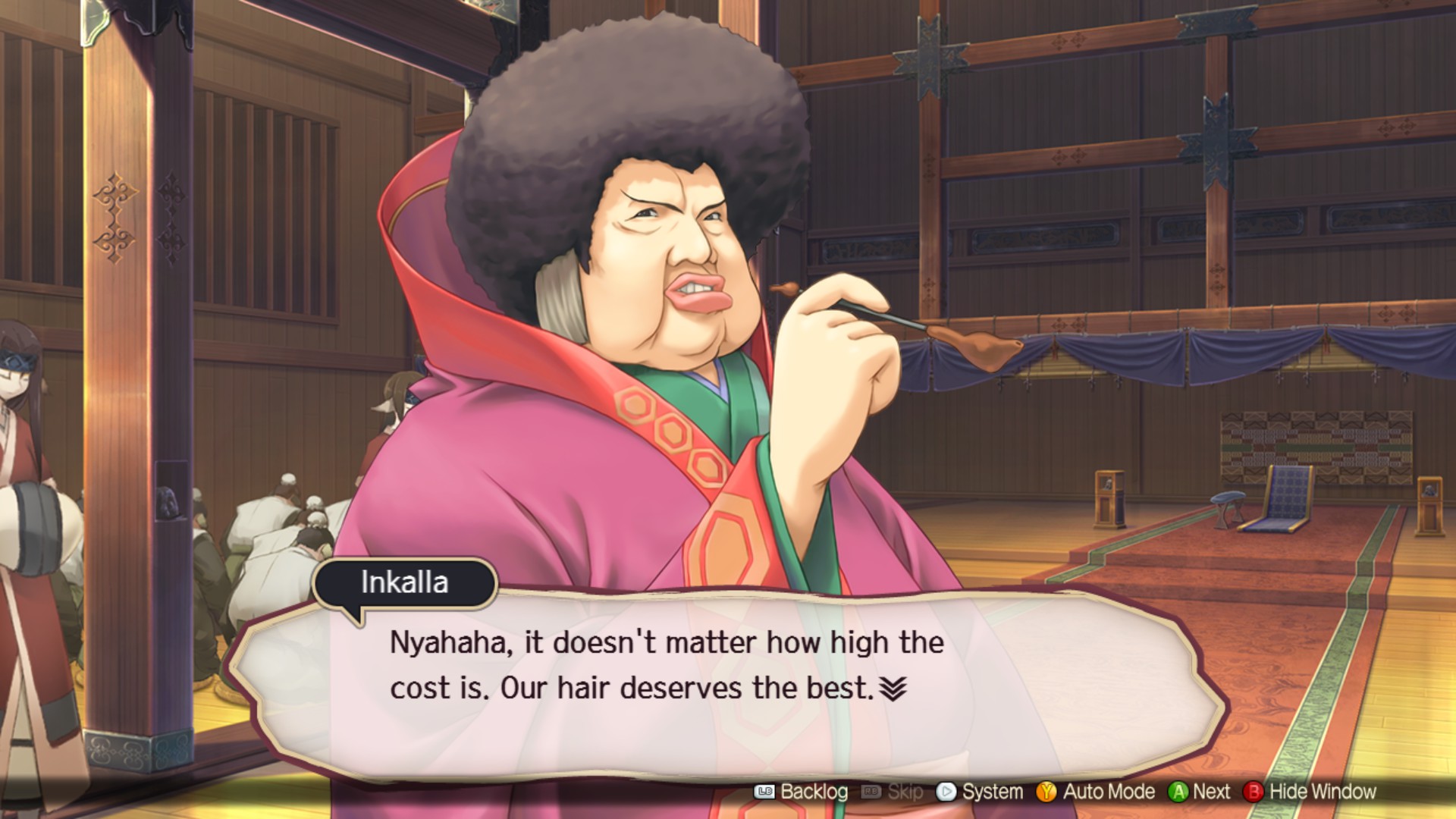
This dumps cold water on the serious drama they’re trying to go for, because now the noble general guy torn between doing what is his duty and what is just guy has to try to explain how destroying the kingdom might lead to less taxes for hair product later (only to get stuff thrown at him for his trouble), and it just makes him look like a moron.
Likewise, yeah, I’m going to say that a rebellion that might get peasants killed along the way is going to be just considering the alternative is letting this cartoon villain kill absolutely everyone, which is the way this game frames the choice. It also makes the supposedly brilliant general torn between duty and morality look like a dope because there’s absolutely no justifying swearing fealty to someone so obviously unqualified for absolute authority.
They want to have a big-boy grownup morally gray story, but they’re not brave enough to let the villains actually have a leg to stand on or make the arguments used to undercut the hero’s side have any actual weight, which means that the protagonist looks like a whiny moper for being guilty of supposedly terrible deeds the plot goes completely out of its way to assure you were totally unavoidable.
This does get somewhat better with later villains, although that moves into spoiler territory, but there is a clear overall trend of how much you’re supposed to sympathize with a character being directly correlated to how attractive they are.
The Lack of Porn
One thing a certain extremely and insistently vocal minority is disappointed about is the lack of pornographic content in Utawarerumono. Like many indie Japanese games of its time, the original 2002 version of Utwarerumono had sex scenes, but these scenes were cut while a significant amount of content was added to the game in the port to the PlayStation 2, which has been the version of the game every subsequent port has been using.
There never was going to be, and almost certainly never will be a patch to put the porn back in. This isn’t censorship to get on Steam that complaining about it on the forums is going to bring about a change over, this is censorship by Sony two decades ago, and nearly every visual novel from around this time period that got a PlayStation release (which is basically all of them that got even the slightest bit popular) went through this same process, so complain to Sony twenty years ago, not Valve now.
All told, if you’re only looking for porn, there are better places to look than a 60 hour visual novel and tactics RPG that only has half a dozen sex scenes to start with, anyway.
With all that said, the bleaching of the underwear, as it were, is not totally complete, by which I mean that there are still traces of the fact that this started as a game with porn in it left in the script. In particular, this can be noticed in the way that the cast is female-heavy for a game about a pseudo-historical war, and nearly every recruitable female character shows romantic interest in the main character. The po-faced political drama and military strategy story threads that try to build up tension in the story get broken up by random “ecchi comedy” scenes like where Hakuowlo tries to help with the laundry, only to embarrass Eruruu by putting up her bra to dry, and you then [sigh] find Eruruu’s bra as a collectable item in the glossary, which is an item you need to collect to get the 100% item completion achievement…
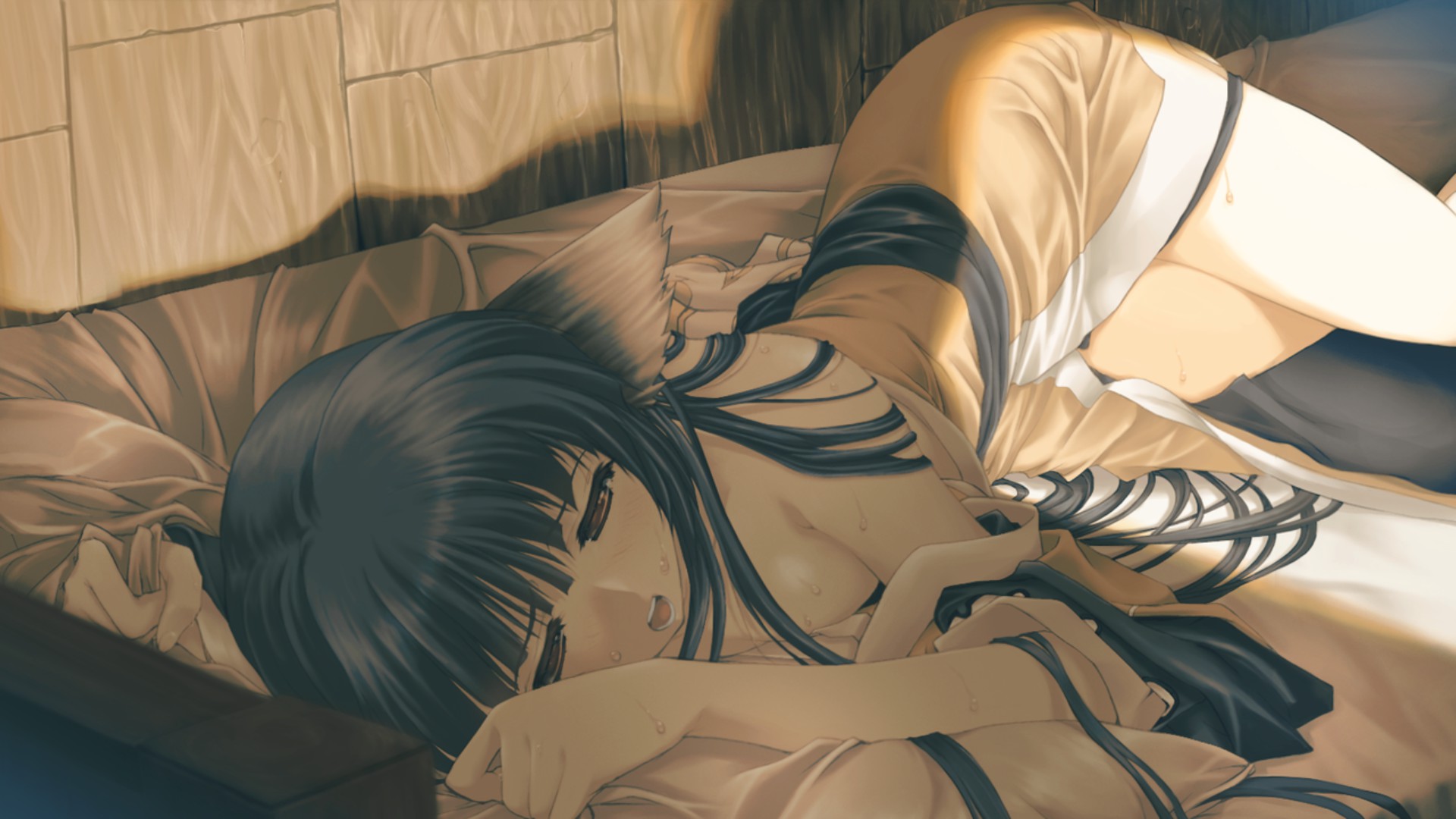
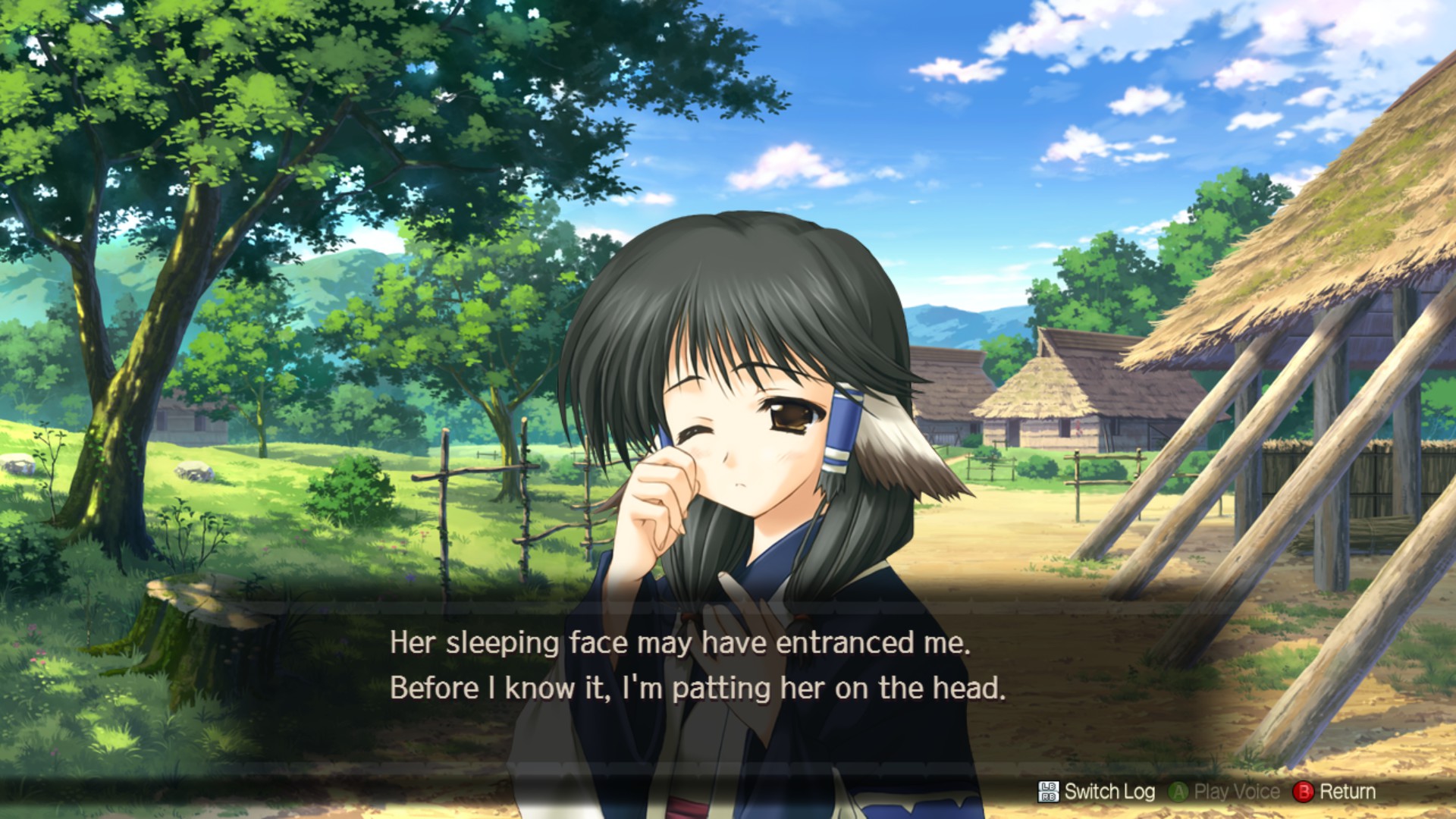
Day 1 DLC
One thing sure to leave a sour taste in the mouth of a few gamers is the fact that Utawarerumono came with Day 1 DLC. Because this is a re-re-re-re-release of an old and completed game, this isn’t “carving out content” as some would jump to conclude, but rather, they are the characters of the sequel games that can be added into your roster in this game. Since every stage has a unit cap based upon the number of characters you could field according to the plot, you basically can’t put one of these DLC characters into a battle without pulling one of the actual plot characters out of battle, so it doesn’t even work as a pay-to-win mechanic, and they obviously have no bearing on a plot when they aren’t introduced until the next game that takes place in another generation of characters.
The fact that it isn’t worth buying means this probably isn’t a great set of DLC, as it still gets some sour looks for trying to cash in on assets from other games while at the same time only actually taking the money of desperate completionists that would buy literally any DLC.
Visuals
I discussed the general state of the visuals in the porting section near the start of this article, but there are still a few issues to point out. First is that this is primarily a visual novel, but still a story filled with action scenes, which means that there are a lot of narrative beats that involve conflict that are only described in text, and even then, only vaguely. There are extremely few individual sprites for every character, enough so that many characters don’t even have different emotional expressions, and many generic soldiers or villagers just do not appear in the visual novel sections at all. There’s only a pool of five general villagers from the original village, and none of the refugees that get brought in have a name or face or any speaking lines.
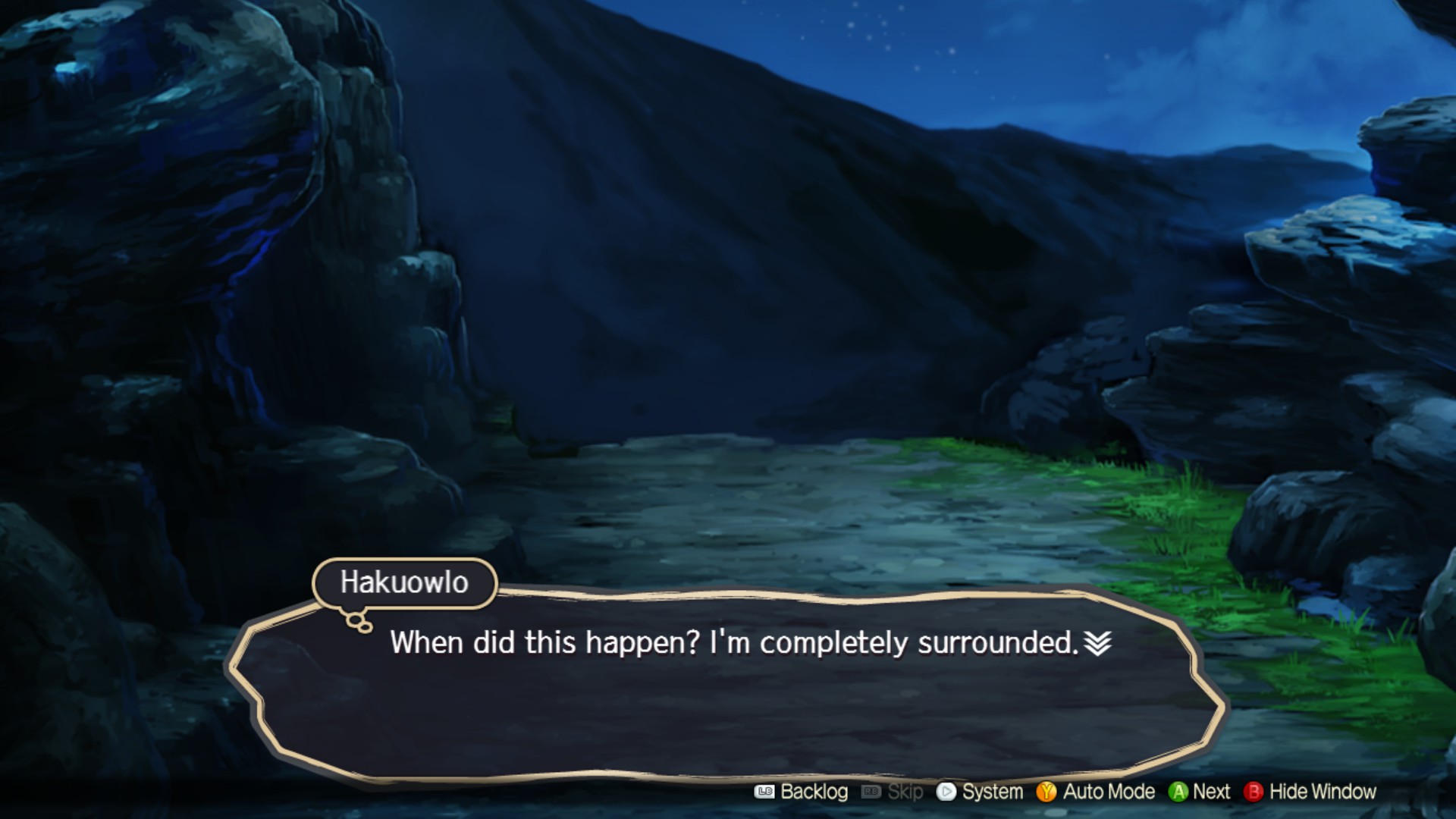
Beyond that, while some scenes are rendered in the battle engine, many character models are very limited in their animations, an artifact of the budget title origins of this game. This means characters turn just by rotating without moving their legs, for example, and only a few of them have animations of their mouths.
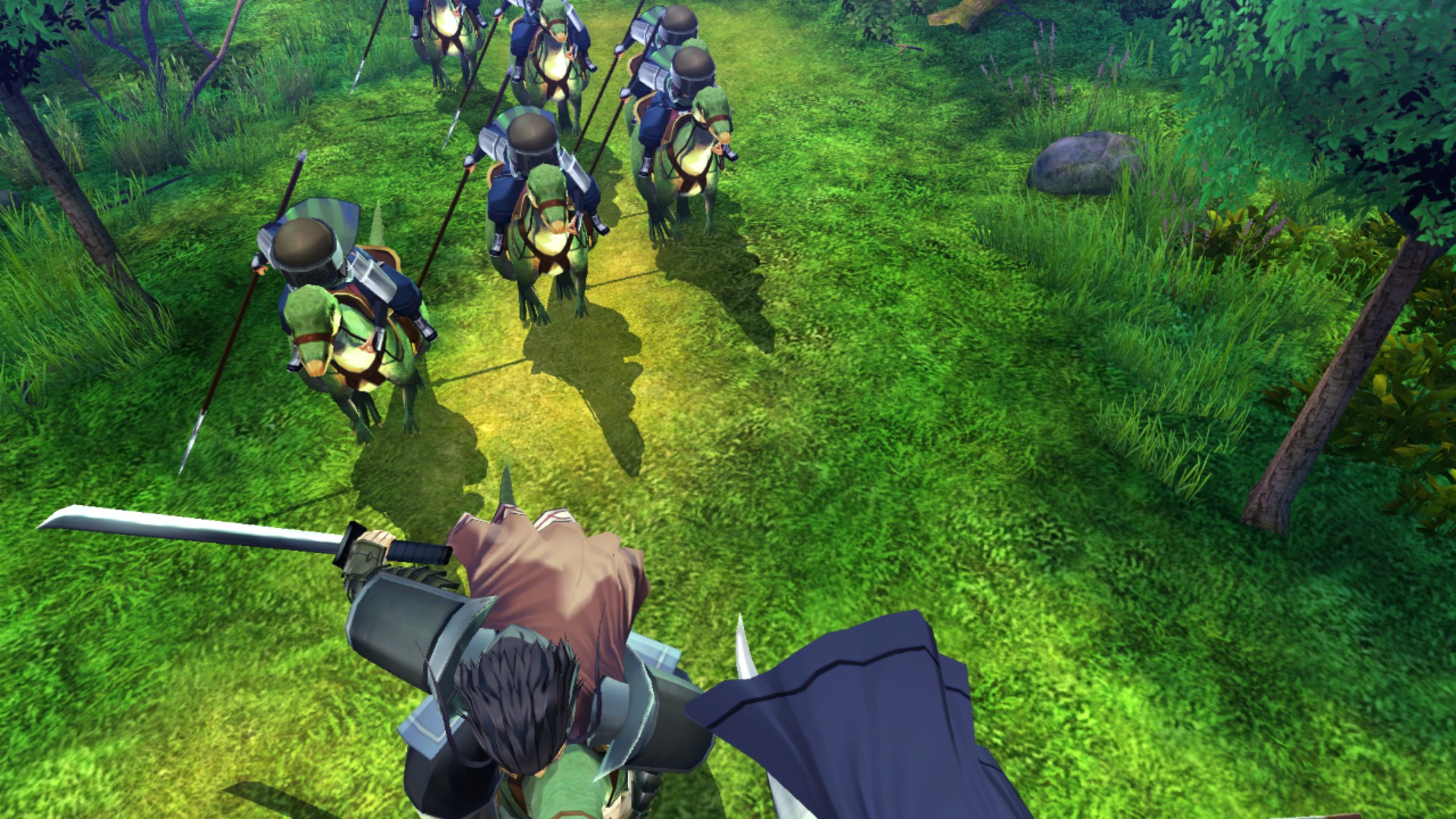
All told, it may be worth watching the anime in conjunction with playing the game to get the full cinematic experience going. Some elements of the story were cut for time in the anime, but unless you really enjoy imagination theater, it’s still a more satisfying and complete experience to watch battles that have a hundred peasant soldiers in the background than battles where the same six guys do all the fighting for an entire kingdom.
Sound
Japan has long been picky about voice acting, so even games with limited budgets like Utawarerumono’s original release do not skimp on voice actor budgets. The voicework was certainly expanded for the PS2 release, but sound overall is of great quality, with the exception of a few sound effects I found a little vague. Sound effects often fill in for text descriptions in a visual novel that skimps on what it actually shows visually, so having what turned out to be the “gulping water from a canteen” sound actually sound more to me like a “boots in thick mud” sound confused me for a bit.
The only real complaint I have is that there are a few song tracks that include vocals that play during key dramatic moments in the story… which also feature voiced dialogue. Having two voices going on at once can ruin dramatic dialogue’s impact, as can having to mute the music to hear the dramatic lines as they were intended to be delivered.
Verdict
This port accomplishes everything a port reasonably can. Utawarerumono is still getting re-releases nearly two decades later for a reason, and that’s because it was a compelling story with good gameplay to back it up, but it’s also part of a niche sub-genre. A visual novel is a pretty niche genre, and if you’re here just for a tactics RPG, you’re going to find this far too story-heavy. Someone just into visual novels is also probably not going to be amused by a tactics RPG in the middle of their story, even if they can turn the difficulty down, and won’t be amenable to grinding to make it easier. If you’re the target audience for this game, you probably know who you are.

